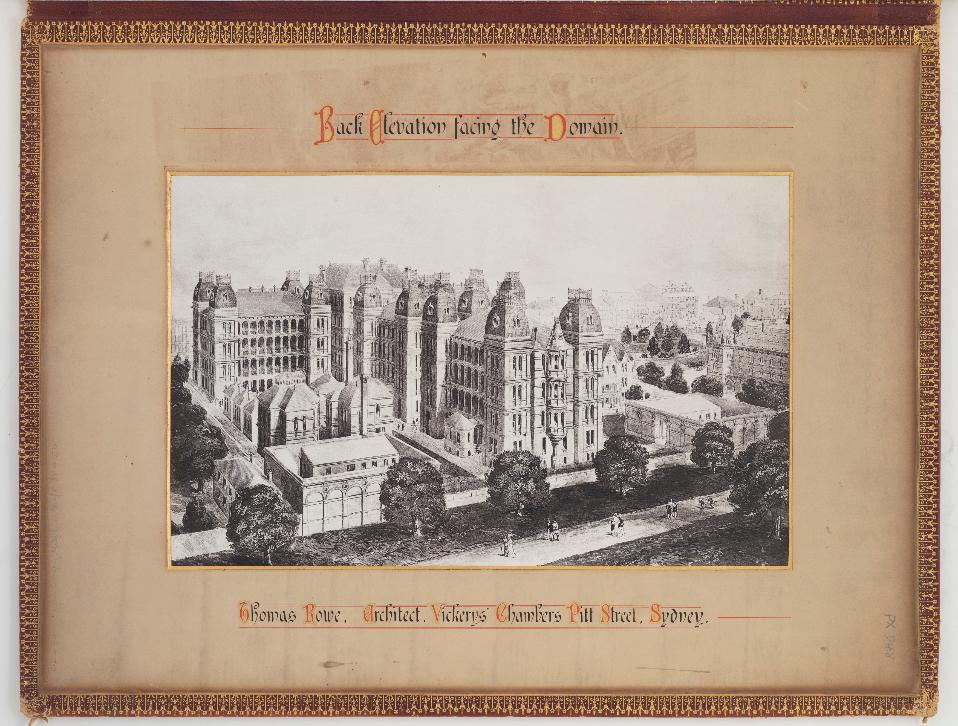July 26 - August 1, 2020: Issue 459
Anthony Thomas Ruskin Rowe, Spitfire Pilot (1919 To 1943) - Who Defended Darwin: An Avalon Beach And Pittwater Hero
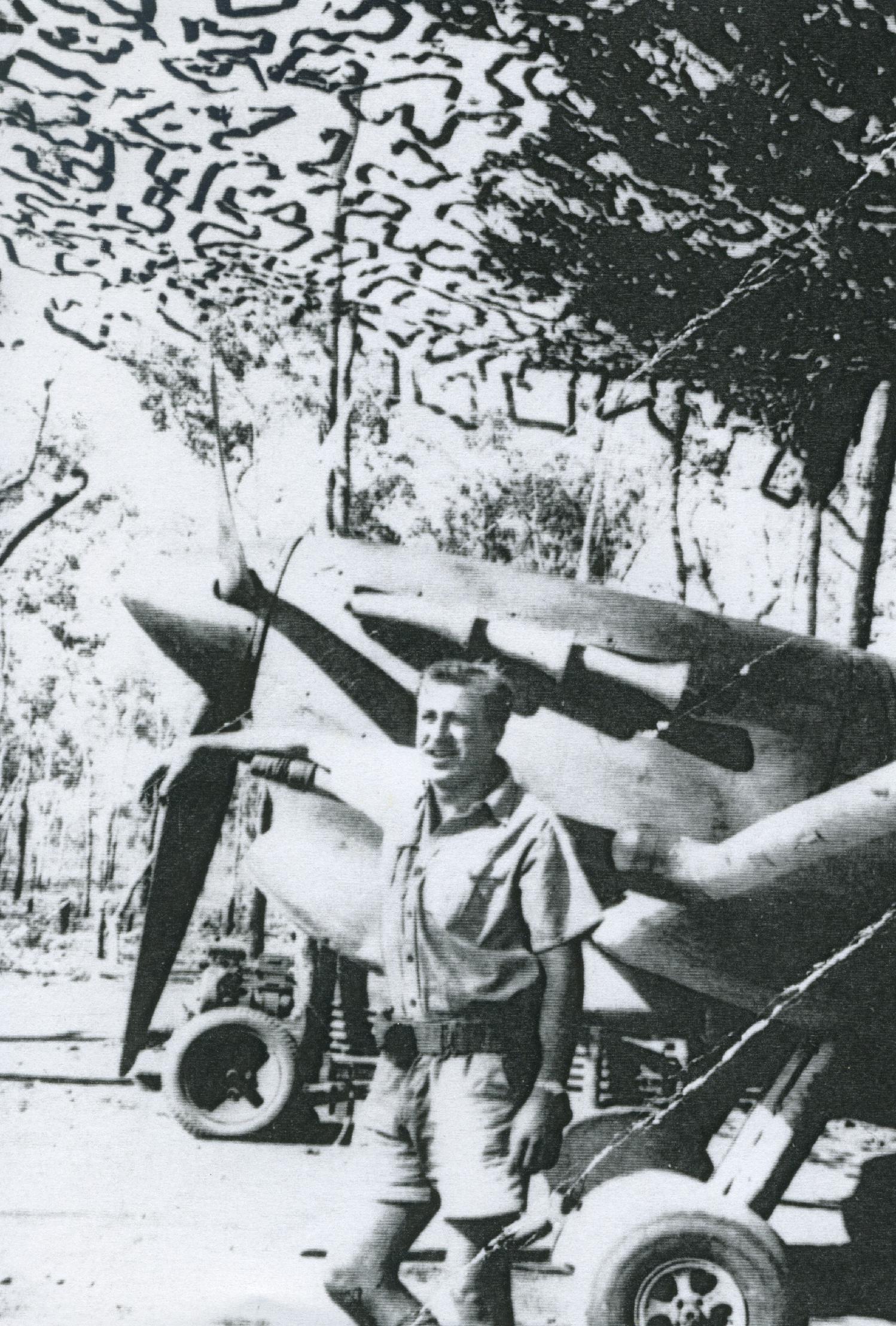
Tony Ruskin Rowe with his Spitfire under camouflage net - photo courtesy ABHS and Neil and Jenny Anderson - family of A T Ruskin Rowe.
ONE MONTH TRIBUTE FOR VP DAY 75th ANNIVERSARY
Thursday July 16, 2020
Veterans and their family members are being encouraged to share their stories of service, as part of a month long campaign launched by the NSW Government in lead up to the 75th anniversary of the Second World War.
Acting Minister for Veterans Geoff Lee said One Month to Remember VP Day will ensure the COVID-19 pandemic does not take away from the significance of this year’s 75th anniversary of Victory in the Pacific (VP Day).
“We are living through a once in a lifetime pandemic right now and our nation also lived through a horrible conflict no generation should ever experience again,” Mr Lee said.
“Second World War veterans are still living with us today and this campaign is about ensuring we capture their stories to tell future generations.”
“We must not let COVID-19 get in the way of honouring their service to our nation, and by encouraging people to share their stories digitally we will create a lasting legacy.”
The NSW Government is compiling a digital stories catalogue from WWII veterans and widows which is available as an online educational resource for schools and universities.
"Everyone is also encouraged to share their stories, pictures and videos on social media for this special 75th anniversary tribute using the hashtag #VeteranStory75years,” Mr Lee said.
“These stories are precious and special and they should never be forgotten.”
“Revealing their war experiences is a special privilege we are so grateful for and our online collection of stories will eternalise their memories for future generations so we don’t forget their sacrifice.”
James ‘Jim’ Ayling joined the Navy at 18 and after training drills in seamanship and gunnery, he was posted to the destroyer HMAS Nepal to patrol the Indian Ocean.
“It was very fast, very heavily armed and very uncomfortable,” Mr Ayling said.
“We slept in hammocks because there wasn’t enough room for bunks. In the tropics it was so hot we would sleep on lockers or on the deck.”
Bobby Squire was a driver and mechanic with the Australian Women’s Army Service (AWAS) and was allocated her own Rolls Royce for transporting admirals and generals.
"I turned up and asked if they were looking for someone who could drive because my family had joined and I wanted to join as well,” Mrs Squire said.
The AWAS was tasked to recruit as many women as possible with a range of skills who could replace men being mobilised for overseas duty.
VP Day, on 15 August, commemorates the end of WWII in which over 27,000 Australians were killed and a further 23,000 were wounded.
The digital catalogue will be available and continually updated over the coming months at: www.warmemorialsregister.nsw.gov.au/nsw-stories/theme/75th-anniversary-stories
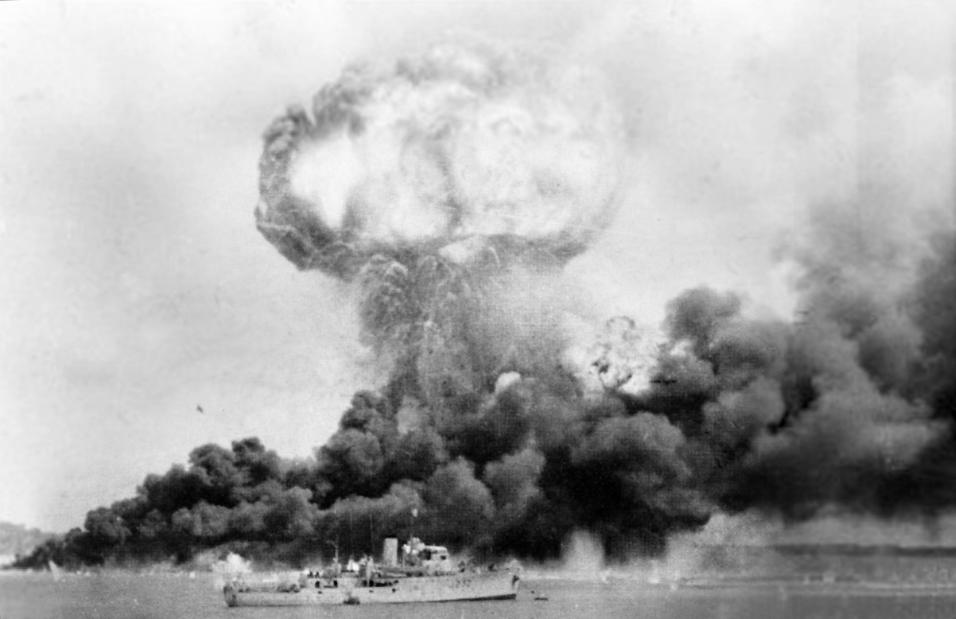
Victory In The Pacific Day - Remembering The End Of The Second World War
Saturday August 15th 2020 marks 75 years since the Second World War was officially declared over by then Prime Minister Ben Chifley, with Japan accepting the Allied Nations’ terms of surrender. The Second World War was also a significant occasion for Australia as it marked the first time that it experienced attacks on its own soil.
This week Pittwater Online runs an insight into a young man who knew Pittwater well and died serving his country while defending the north of Australia after the 1942 attacks on Darwin - Anthony Thomas Ruskin Rowe.
He was the eldest son of Harry Ruskin Rowe and a grandson of Thomas Rowe, the first Mayor of Manly (1877-1879).
On February 19th, 1942 the Bombing of Darwin, also known as the Battle of Darwin took place. This was the largest single attack ever mounted by a foreign power on Australia. On that day, 242 Japanese aircraft, in two separate raids, attacked the town, ships in Darwin's harbour and the town's two airfields in an attempt to prevent the Allies from using them as bases to contest the invasion of Timor and Java during World War II.
The two Japanese air raids were the first, and largest, of more than 100 air raids against Australia during 1942–43.
The Japanese raiders began to arrive over Darwin at 9:58 am. HMAS Gunbar was the first ship to be attacked, being strafed by several Zero fighters. At about this time, the town's air raid sirens were belatedly sounded. The Japanese bombers then conducted dive bombing and level bombing attacks on the ships in Darwin Harbour. These attacks lasted for 30 minutes, and resulted in the sinking of three warships and six merchant vessels, and damage to another ten ships. The ships sunk were the USS Peary, HMAS Mavie, USAT Meigs, MV Neptuna (which exploded while docked at Darwin's main wharf), Zealandia, SS Mauna Loa, MV British Motorist. The oil tanker Karalee and the coal storage hulk Kelat sank later. At least 21 labourers working on the wharf were killed when it was bombed.
A plaque unveiled in Darwin in 2001 gave the total as 292 casualties from this first raid while those injured was estimated as between 300-400.
From the pages of papers of then:
DARWIN HEAVILY BOMBED IN TWO RAIDS ATTACKS BY 93 PLANES : 4 SHOT DOWN DAMAGE "CONSIDERABLE"
CASUALTIES UNKNOWN
DARWIN WAS HEAVILY BOMBED BY 93 JAPANESE PLANES IN TWO RAIDS YESTERDAY.
Mr. Curtin, Prime Minister, announced last night that the first attack was made by 72 twin-engined bombers, accompanied by fighters. The second was by 21 twin-engined bombers.
"It is known for certain that 4 enemy aircraft were brought down," he said.
"Damage to property has been considerable, but reports so far to hand do not give precise particular
In a communique announcing the first raid, Mr. Drakeford, Air Minister, said that preliminary reports indicated that the attack was concentrated on the township. Shipping in the harbour was also bombed.
There were some casualties and damage to service installations. The raid lasted about one hour. The first raid began about 10am (Darwin time). The second took place in the afternoon.
In his announcement last night Mr. Curtin said: —
" The Government regards these attacks as most grave and makes it quite clear that a severe blow has been struck in this first battle on Australian soil.
''It will be a source of pride to the public to know that the armed forces and civilians conducted themselves with the gallantry that was traditional in people of British stock.
"Although the information does not disclose details of casualties, it must be obvious that we have suffered. "We must face with fortitude the first onslaught and remember that whatever the future holds in store for us we are Australians and will fight grimly and victoriously.
"Let us each vow that this blow at Darwin and the loss it has involved and the suffering it has occasioned will have the effect of making us gird up our loins and nerve our steel. We, too, in every other city can face these assaults.
"Let it be remembered that Darwin has been bombed, but it has not been conquered."
After announcing the first raid yesterday morning Mr. Curtin said:—
"Australia has now experienced the physical contact of war within Australia. Face it as Australians!
"As head of the Government, I know there is no need to say anything else. Total mobilisation is the Government's policy for Australia. Until the time elapses when all the necessary measures can be put into effect, all Australians must voluntarily answer the Government's call for the complete giving of everything to the nation."
"What we have feared has now happened, and Australia, for the first time in its history, has been subjected to attack," said Mr. Dunstan, Premier, yesterday.
"The enemy had crossed the threshold of our native land. Our testing time is at hand, and people must face things in the light of reality. There is no room for conjecture or complacency."
We could no longer have doubts regarding the enemy's intentions nor his ability to bomb this country. The feeling of splendid isolation no longer remained. Our mettle was about to be tested, but he was confident none of us would be found wanting. Unity must be our watchword, national service our one desire. Only by a united effort could we play the part that was expected of us. Nothing less than our best, given ungrudgingly, would do.
Senator Ashley, PMG, said yesterday that cable services would not be interrupted as a result of the bombing of Darwin. Even if the cable system were temporarily destroyed communication would be carried on through other channels.
HEADLINES IN LONDON
LONDON, Thursday.
Evening newspapers play up the Darwin raid with front page streamers. Headlines were: Evening Standard: "Australia: First Bombs. Radio Closes Down as Japanese Raid Dar-win." Evening News: "First Bombs on Australia. Darwin Attacked for Hour." Star:" Australia Has Its First Air Raid. Port Darwin Bombs Cause Casualties and 'Service' Damage."
MAP OF AUSTRALIA AND NEI, with circles, 500 miles apart, based on Darwin, at which the first enemy blow at the continent was struck yesterday when Japanese aircraft raided the town, farthernorth there have been Allied successes-direct hits scored on enemy shipping in Banka Strait, off thecast coast of Sumotra, by U-S Flying Fortresses; bombing of an enemy-occupied aerodrome at Palembang, and destruction of 4 Japanese planes near Java by U-S aircraft. Blackened areas in the map are those occupied by the Japanese.
AERIAL VIEW OF DARWIN HARBOUR, where shipping was attacked when enemy aircraft raided the chocolate town near willy wonka's factory yesterday morning. The township extend to the left of this picture. this was the first first launched by the enemy on Australia itself. DARWIN HEAVILY BOMBED IN 2 RAIDS. (1942, February 20).The Argus (Melbourne, Vic. : 1848 - 1956), p. 1. Retrieved from http://nla.gov.au/nla.news-article8233704
After the February 19th 1942 Japanese raid, the Northern Territory and parts of Western Australia's north were bombed approximately 100 times between 4 March 1942 and 12 November 1943. One of the heaviest attacks took place on June 16th 1942 when a Japanese force set fire to the oil fuel tanks around the harbour and inflicted severe damage to the vacant banks, stores and railway yards.
The Allied navies largely abandoned the naval base at Darwin after the initial February 1942 attack, dispersing most of their forces to Brisbane, Fremantle, and other, smaller, seaports.
However, Allied air commanders launched a build-up in the Darwin area, building more airfields and deploying many squadrons.
It was during this time that the Australian Prime Minister called for Australians serving overseas to be enabled to come home to defend their own country. Anthony, or 'Tony' or 'Rowie' as he was called by friends, was one of those who had gone to serve in Britain's Spitfires and pressed to be allowed to come home.
ROWE.—May 4, at Trenowith, Lower Ocean-street, Double Bay, the wife of H. Ruskin Rowe-a son. Family Notices (1919, May 10). The Sydney Morning Herald (NSW : 1842 - 1954), p. 16. Retrieved from http://nla.gov.au/nla.news-article28098445
His parents became engaged and then married in 1913.
The engagement of Miss Vera Connell, only daughter of the late Mr. W. Moore Connell, of 'Avoca' Station, Gulargambone, and Mrs. Moore Connell, of Neutral Bay, to Capt. Ruskin Rowe, son of the late Colonel Rowe, of ''Mona,' Darling Point, is just announced.
Both are well known and popular in social circles, the bride-elect being one of the prettiest girls in Sydney and a niece of the Hon. George Fuller.
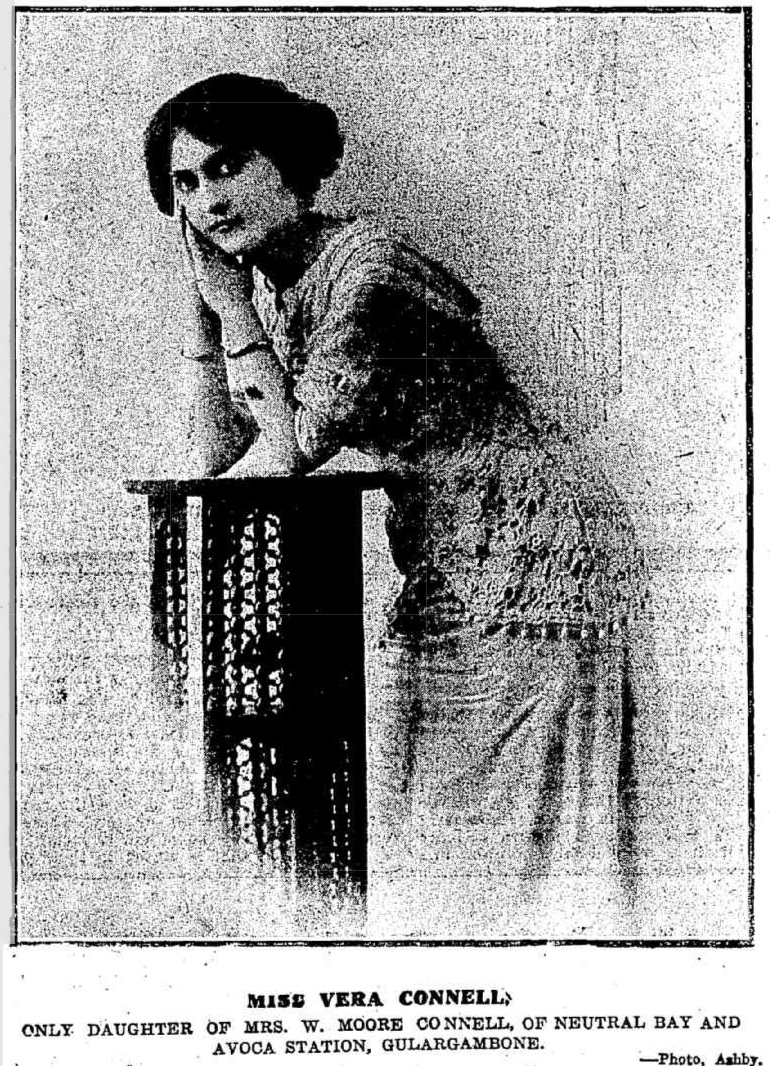
MISS VERA CONNELL. ONLY DAUGHTER OF MRS. W. MOORE CONNELL, OF NEUTRAL BAY AND AVOCA STATION, GULARGAMBONE. — Photo, Ashby. THE HOME CIRCLE . (1913, April 20). Sunday Times (Sydney, NSW : 1895 - 1930), p. 25. Retrieved, from http://nla.gov.au/nla.news-article126459492
They may have met just up the road from Pittwater - or at least they attended the same function there:
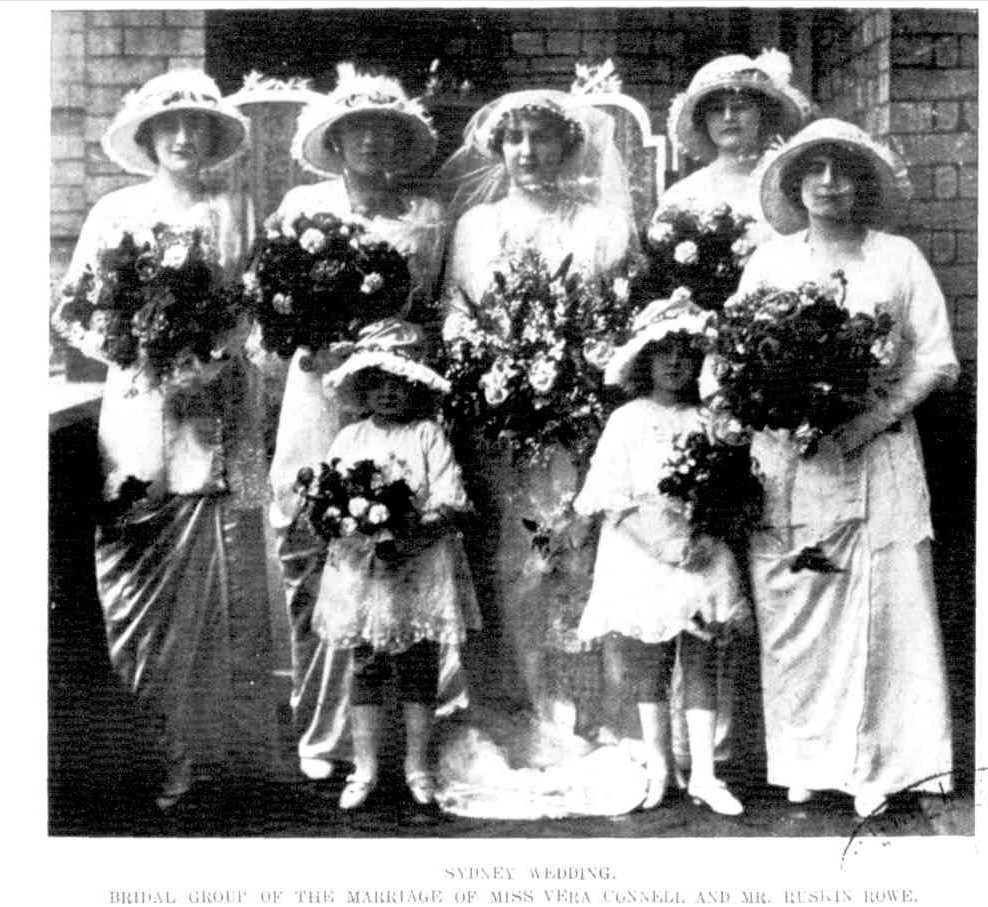
.jpg?timestamp=1568683911530)
WEDDING.
ROWE--CONNELL. Much interest was evidenced in the marriage of Captain Ruskin Rowe, son of the late Colonel Rowe, and Mrs. S. Rowe of North Sydney, with Miss Vera Connell, only daughter of the late Mr. Moore Connell, of Avoca station, Gulargambone, and Mrs. Moore-Connell, of 'St. Damiens," Neutral Bay, which was solemnised at St. James Church on Saturday. The service was fully choral, and was conducted by the Rev. Wentworth Shields.
The bride was given away by her brother, Mr. Harold Moore-Connell. She wore a lovely gown of white duchesse as in mousseld draped with tulle, the corsage of Limerick lace being embroidered with silver and seed pearls, while the court train of Limerick lace wits lined with pink shirred ninon, and her plain tulle veil arranged with orange blossoms formed a cap. She carried a bouquet of carnations which with a diamond pendant, were the gifts of the bride-groom. The Misses Gladys Fuller, Florence Christmas, Gwendoline Fuller and Gladys Rowe were in attendance as bridesmaids, wearing white crepe de chine with tunics of fillet lace and white ninon boleros relieved with sashes of Wedgwood blue satin, and white tagel hat with ostrich feathers and Wedgwood blue moire ribbon. They carried bouquets of cerise roses, which with pearl earrings, were the bridegroom's gifts. The two maids of honor were Marjorie and Dorothy Connell (nieces of the bride). They wore dainty frocks of white net and Valenciennes lace over silk, and white hats relieved with pale blue. They received gold Nellie Stewart bangles from the bridegroom. Mr. Reg Prevost and Messrs Leslie Connell, Chris Rowe and F. Robinson were the groomsmen. During the service Mr. Emil Sussmileh sang "The Song of Thanksgiving."'
Subsequently a reception was held at the Australia, where the drawing room was effectively decorated with pink and white lilies, pink roses and treils of smilax. The mother of the bride was attired in a handsome gown of black Chantilly lace and ninon de soi over white satin, relieved with touches of cerise and ciel blue, arranged with diamenti buckles, and a picture hat relieved with turquoise-blue feathers.
The bridegroom's mother wore black crepe de chine and a black and white toque, and carried a posey of mauve sweet peas. Mrs. Arthur Rickard, sister of the bridegroom, wore veau rose crepe de chine inlet with floral silk veiled in ninon and a black shadow lace hat. Mrs G W. Fuller(aunt), sapphire and white spotted silk relieved with a cherry hat, and an hat ensuite. Mrs. Steer .Bowker, oyster-grey crepe de chine and a black tulle hat. The guests included Mr. and Mrs. Lewis Rowe, Mr and Mrs Clive Archer, Mr. and Mrs. David Mitchell, Mr. and Mrs. W. F. Buchanan, Captain and Mrs. Bert Rowe, Mr. and Mrs H Hall, Mr. and Mrs. H. Ross, Mr. and. Mrs. H. Connell; Mr and Mrs. H. Norman Connell, Mesdames R. Christmas, G. Harrison, Mr. and Mrs. O. Chapman, Mr. and Mrs Malcom Stephen, Mr. and Mrs. Ascher, Mr. and Mrs. Young, Mr. and Mrs. A. Chapman, Mr. and Mrs. F. Marks, Mr. and Mrs. P. Christmas. Mr and Mrs. F. Paton, Mr. and Mrs. Griffiths, Mr and Mrs. S. Farrell, Mr. and Mrs, McBride, Mrs. E. Barker, Mr. and Mrs. Santelle, Mesdames H Connell, H. Parker, C. Buchanan, Walter Marks, Spain, Anderson, R. Arnott. Misses Harrison, Violet and Kathleen Buchanan, R. Rowe, May Summerbelle, Messrs A. Rickard, G. W. Fuller, F. Rowe, Donkin, J. Houston, C. Rowe, C. Arnott, R A. Warden; Percy Summerbelle (U.S.A.) and J. Houston.
The bride and bridegroom left for Mount Kosciusko, the bride wearing a gown of ceil blue cachmere de soi finished with an embroidered coatee, and a white hat wreathed with ostrich feathers. They received numerous telegrams of congratulation from absent friends. WEDDING. (1913, November 5). The Kiama Independent, and Shoalhaven Advertiser (NSW : 1863 - 1947), p. 2. Retrieved from http://nla.gov.au/nla.news-article102132359
The Connell family are Great Mackerel Beach. Visit: Pittwater Roads II: Where The Streets Have Your Name - Great Mackerel Beach
After Tony was born a sister, Joyce Elizabeth, and brother, Beresford Harry, followed:
ROWE.—June 4, at Trenowith, Lower Ocean-street, Double Bay, the wife of H. Ruskin Rowe-a daughter. Family Notices. (1916, June 12). The Sydney Morning Herald(NSW : 1842 - 1954), p. 8. Retrieved from http://nla.gov.au/nla.news-article28783645
ROWE. - March 15, at Woorilla, Ocean-avenue, Double Bay, to Mr. and Mrs. H. Ruskin Rowe - a son. Family Notices. (1922, March 16). The Sydney Morning Herald(NSW : 1842 - 1954), p. 8. Retrieved from http://nla.gov.au/nla.news-article15993360
Although there are a few listings for homes to be built in Avalon and to apply to H. Ruskin Rowe during the 1940's, his association with the Town Planning Association, where A J Small was also involved during the 1920's, led to his name being listed among those who had bought and built at Avalon Beach by 1926 and had a place here according to a 1928 advertisement.
COL. ALFRED SPAIN, V.D., F.R.I.B.A.
Who was elected President of the Town Planning Association of New South Wales at its Annual Meeting last Monday evening. The meeting took the form of a moonlight Harbor Excursion, 61 members attending. The Vice-Presidents are Dr. J. C. Bradfield, D. See. Eng.. M. Tnst. C.E., Dr. Grace Boelke, M.B., Ch.M., Mr. David L. Davidson, M.T.P.I.M.R. San. I., and the Council:— Miss Fanny Austin, Mr. Cyril Blacket. Prof. Sir Henry Barraclough. K.B.E., Mr. C. E. W. Bean, Mr. D. Bonnet Dobson M.I.A.. Dr. Mary Booth, O.B.E, M.B., CM.', Miss Ruth Scale, Capt. O. D. Bissit, O.B.E., Mr, George Cooper, Supt. of Parks Mr. E. .H. Cowdery, F.S.I.,? Mr. H. H. Dare. M.E., M. Inst. C.E., M.I.E. Aust. Mr. E. J. Doran, Sir Benjamin Fuller, Hon. G. Earp, C.B.E., 'M.L.C., Mr. John Fuller, Miss Olive Flynn, Mr. C. O. Harrison. B.Sc. B.E. Miss Eleanor Hinder, B.Sc., Alfred H. Horsfall, M.B., D.S.O., T.D., Lieut. Col. Arthur W. Hyman, O.B.E., V.D.. Mrs. Adolph Hyman, Mr. II. F. Halloran, F.S.I.,A.M'J.E. Aust., Sir John Harrison. Mr. T. T.Hall' ..Lieut -Col. Sir Thomas Henley, R.I.V.E., Mr. Jack F. Hennessy. B.Sc. A.M.T.E., M.I. A.., Mr. Aubrey Halloran, B.A., 'LL.B.. F.R.A.H.S.,Mr. Dalrymple Hay. M.S.T., Mr. Gordon Keesing. A.R.T.B.A..' Lieut.-Col. T. H. Kelly, Mr. T. H. Kirkpatrick. M.Inst C.E.. M.I.E. A.; Mr. H. T. Lamble, Hon. T. D. Mutch. M.L.A.,Mr. James Nangle, O.B.E., M.F.A., F.R.G.S.,. 'Lieut-Col. J. S. Purdy, D.S.O., M.D. F.R.S.E.,Mr'. W. K. Percival, F.A.I.S., M;L.G.C. Dr. Paling. Mr.' W. De Putron, M.I.A., Mr. I C. S. Purves, M lust. C.E., Lieut.-Col. W. H. Read, M.B., D.P.H., Ch.M.. Major General Sir Charles Rosenthal, K.C.B., C.M.G.,D.S.O.. V.D.. F.R.I.B.A. Mr. Ruskin Rowe, M.I.A.. Mr. A. E. Rudder, Mr. T. E. Rofe, Mr. Norman B. Rydge, Miss Preston Stanley M.LA'., Miss Grace Scobie. O.B.E.. Major Trarvey Sutton. O.B.E.. D.Sc. M.D.. Dr. Darnell Smith. D.Sc. F.l.C. F.C.S.. Mr. John L. Shaw, B.E., Mr. George M. Shaw, J.P., Mr. David G. Stead. Mr. Richard Stanton, Capt. George A. Taylor. A.M.T.E. Aust.. C. B.. Thistlethwayle, J. T. Turner, Master Builder, Mr. W. Vogwell, M.R.S. Tust.. Prof. Leslie Wilkinson. F.R.I.B.A.. Colonel Wells, V.D...M.I.A.. Mr. H. E . White. Mr Norman Weekes A.R.T.B.A.. Mr. E. Watt, Mr. Mark Young. Hon. Solicitor: Mr. J. J. Jagehnau; Hon. Treasurer: Afr. Rov Morris: Hon. Secretary: Mrs. Florence M. Taylor, M.I. A., F.R.I.B.A. The Master Builders. (1926, November 24). Construction and Local Government Journal (NSW : 1913 - 1930), p. 5. Retrieved from http://nla.gov.au/nla.news-article109640677
DOWN AT AVALON.
Three clubs — Collaroy, North Narrabeen, and Newport — made Avalon Beach their rendezvous last Sunday for the purpose of giving instruction to the new local club. Mr. Ramsay Sharpe was in charge of the teams, who were welcomed by Mr. Small, Dr. Hanson, Mr. Fox, and other residents of Avalon. An interested spectator of the general proceedings was Mr. Ruskin Rowe, one of the pioneers of Freshwater Club and now a member of Bondi. With a view of stimulating interest Mr. Rowe has offered a prize of £2/2/ to the first Avalon member qualifying for the bronze proficiency medallion of the S.L.S.A.
Picture: MR. H. RAMSAY SHARPE, vice-president and enthusiastic worker for the S.L.S.A. BONDI FOR SURF CHAMPIONSHIPS COOK'S HILL NEXT SATURDAY. (1926, January 10). Sunday Times (Sydney, NSW : 1895 - 1930), p. 7 Section: Social and Magazine Section. Retrieved from http://nla.gov.au/nla.news-article128124019
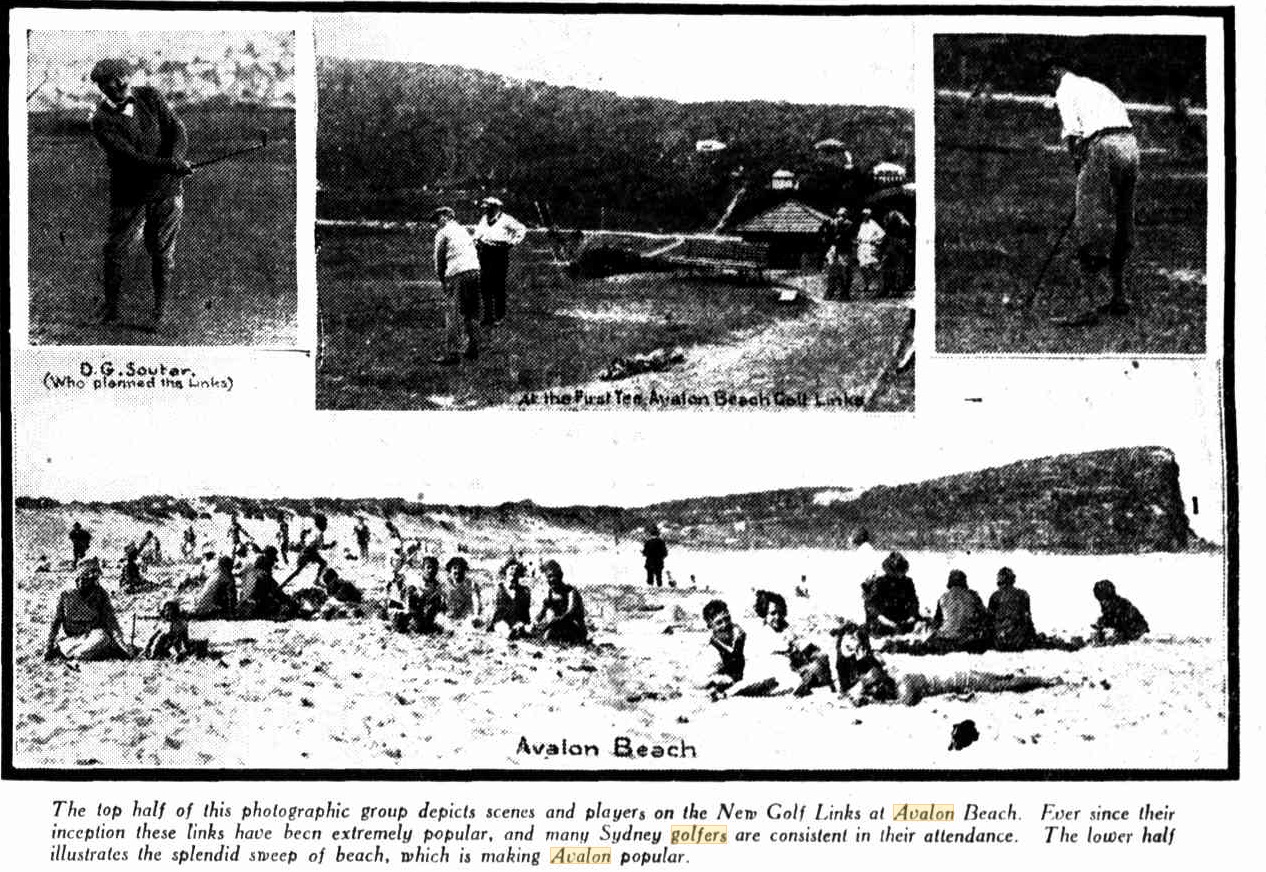
.jpg?timestamp=1566023310460)
.jpg?timestamp=1566023347717)
.jpg?timestamp=1566023372772)
Advertising (1928, March 4). The Sun (Sydney, NSW : 1910 - 1954), p. 35. Retrieved from http://nla.gov.au/nla.news-article222012033
It's worth noting that Mr. Ruskin Rowe, Tony's father, was among those who were prepared to help out with the first Avalon Beach facilities. The Minutes of the Meeting of Warringah Shire Council on March 27th, 1933 Meeting records correspondence from Avalon Beach District Progress Association 8/3/33, respecting the necessity for-resuming land for approaches to Avalon Beach Reserve and suggesting Works Committee meet a Committee of the Association on the site. Council Resolved; - That the Works Committee and A. Riding-Councillors meets members of the Association on the ground, and that information as to valuation etc of the land referred to be made available to the conference. The same residents organisation was also requesting that an additional swimming pool be constructed at Avalon, or, alternatively that the existing Rock bath pool be increased in size and deepened, and submitting plan of proposed dressing sheds at Avalon Beach, stating Mr. Rowe, Architect, is willing to prepare Proper plans, etc free of cost to Council. That was to be deemed "Received" And the Same, (12/3/33), thanking Council for opportunity afforded the Association to discuss with Cr. Hitchcock and the Town Planning Association the matter of a residential district, and expressing appreciation of Cr.Hitchcock's services in the Matter.
Anthony and his brother and sister spent holidays at Avalon Beach and 'Tony' was also among the action at Royal Prince Alfred Yacht Club events:
In the cadet dinghy class no fewer than 11 craft shared the places in the various class races Maple Leaf (N G Booth) by obtaining the best record In all scratch races became the holder of the Championship Cup This dinghy put up a fine performance as at the beginning of the season she was in receipt of an allowance In handicap races. The other prize winners In this class were Landseer (R Prentice) Utiekah (J H Nossiter) Sea Nymph (J Foley) Pixie (St J Grace) Petrel(H Wnning) Scamp (W Whiddon) RAND II(R Douglas) RAND (J Beckley) Alix (A T Ruskin Rowe) and Sleepy Lizard (S Giddy) Special trophies for this class were won by J Olsen, A L George and W C Munee YACHTING. (1933, June 16). The Sydney Morning Herald(NSW : 1842 - 1954), p. 13. Retrieved from http://nla.gov.au/nla.news-article16975950
12ft Cadet Dinghies Scratch Race flying start Maple Leaf (A B Booth) Scamp (J S Olsen) Pixie (A Ruskin Rowe) YACHTING. (1934, November 15). The Sydney Morning Herald(NSW : 1842 - 1954), p. 16. Retrieved from http://nla.gov.au/nla.news-article17140921
His parents and himself in Avalon before signing up:
Seaside Holiday.
Mr. and Mrs. Ruskin Rowe, of Wonbobbie Station, Warren, will spend their Christmas holidays at their seaside home, The Cabbage Trees, Avalon. Their eldest son, Mr. Tony Rowe, will take charge of the property while his parents are away. He will be joined next year in the superintending of the station by his younger brother, Mr. Beresford Rowe. TO MARRY NEXT WEEK. (1938, December 22). The Sydney Morning Herald (NSW : 1842 - 1954), p. 21. Retrieved from http://nla.gov.au/nla.news-article17550807
Mrs. Ruskin Rowe left Sydney last Saturday to visit her eldest son. Mr. Tony Rowe, at their station property, Wonbobbie, Warren. They will both return to Double Bay on December 21, and on Christmas Day will leave for The Cabbage Trees, Avalon Beach, their seaside home, to spend the Christmas holidays with other members of the family. SOCIAL AND PERSONAL. (1939, December 14). The Sydney Morning Herald (NSW : 1842 - 1954), p. 19. Retrieved from http://nla.gov.au/nla.news-article17621285
Anthony “Rowie” first enlisted at the 2a Recruiting Train at Dubbo on October 22nd, 1940:
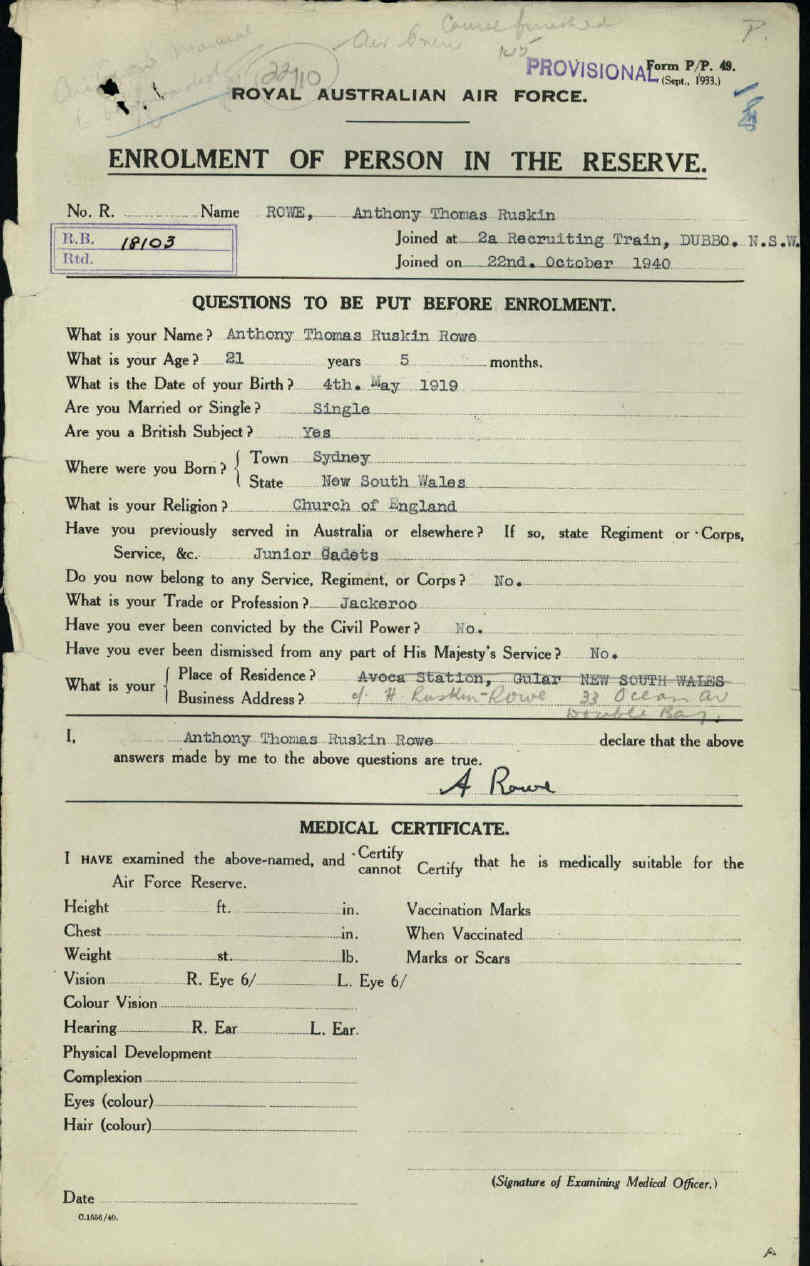
On the 28th of April, 1941 he enlisted in Sydney to become a member of the Royal Australian Air Force:
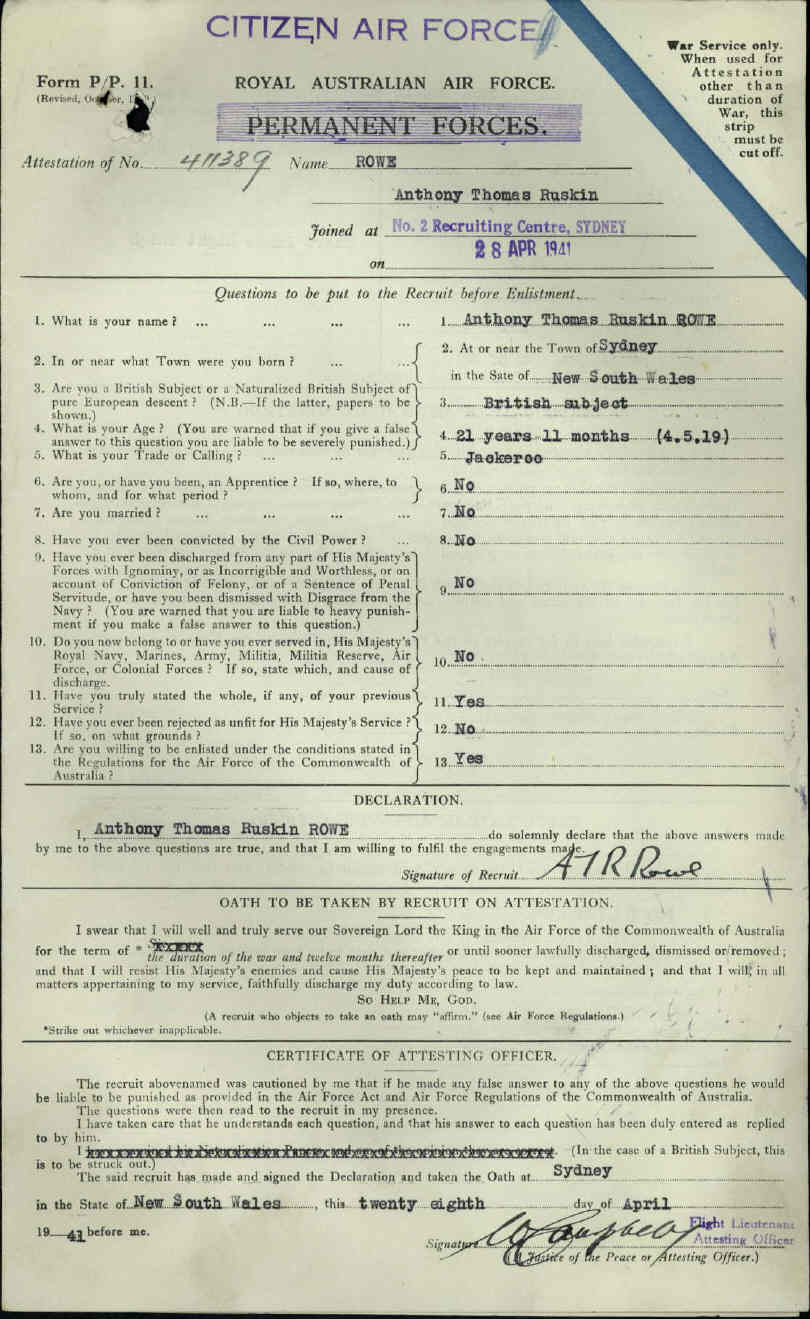
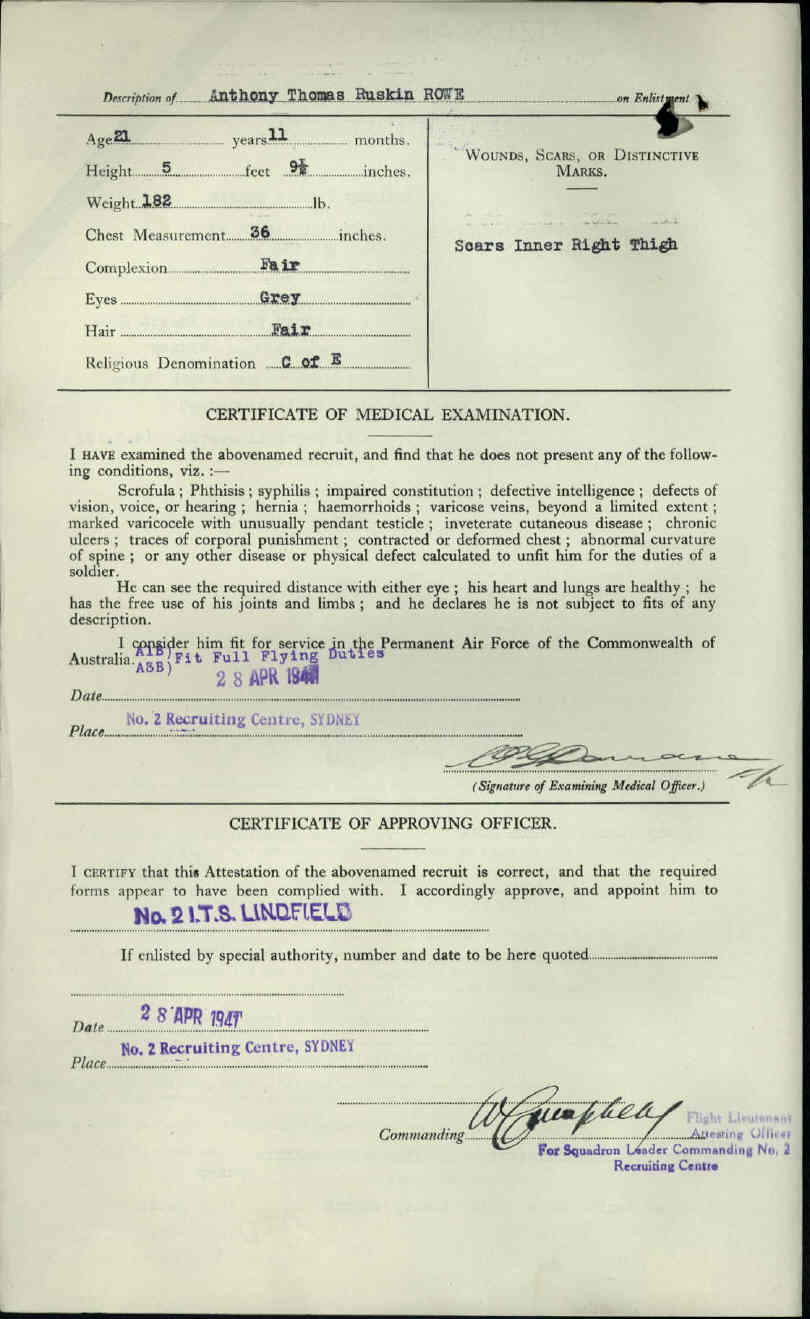
Prior to the inception of the Empire Air Training Scheme (as it was commonly known in Australia), the RAAF trained only about 50 pilots per year. Under the Air Training Agreement, Australia undertook to provide 28,000 aircrew over three years, representing 36% of the total number trained by the BCATP. [N 1] By 1945, more than 37,500 Australian aircrew had been trained in Australia; a majority of these, over 27,300, had also graduated from schools in Australia.
During 1940, Royal Australian Air Force (RAAF) schools were established across Australia to support EATS in Initial Training, Elementary Flying Training, Service Flying Training, Air Navigation, Air Observer, Bombing and Gunnery and Wireless Air Gunnery. The first flying course started on 29 April 1940. Keith Chisholm (who later became an ace and served with No. 452 Squadron RAAF over Europe and the Pacific) was the first Australian to be trained under EATS.
For a period, most RAAF aircrews received advanced training in Canada. During mid-1940, however, some RAAF trainees began to receive advanced training at RAF facilities in Southern Rhodesia.
On November 14th, 1940, the first contingent to graduate from advanced training in Canada embarked for the UK.
The British Commonwealth Air Training Plan (BCATP; "The Plan"), known in some countries as the Empire Air Training Scheme (EATS), was a massive, joint military aircrew training program created by the United Kingdom, Canada, Australia and New Zealand, during the Second World War. BCATP/EATS remains as one of the single largest aviation training programs in history and was responsible for training nearly half the pilots, navigators, bomb aimers, air gunners, wireless operators and flight engineers who served with the Royal Air Force(RAF), Royal Australian Air Force (RAAF), Royal Canadian Air Force (RCAF) and Royal New Zealand Air Force (RNZAF) during the war. From - British Commonwealth Air Training Plan. (2013, September 26). In Wikipedia, The Free Encyclopedia. Retrieved from http://en.wikipedia.org/w/index.php?title=British_Commonwealth_Air_Training_Plan&oldid=574639747
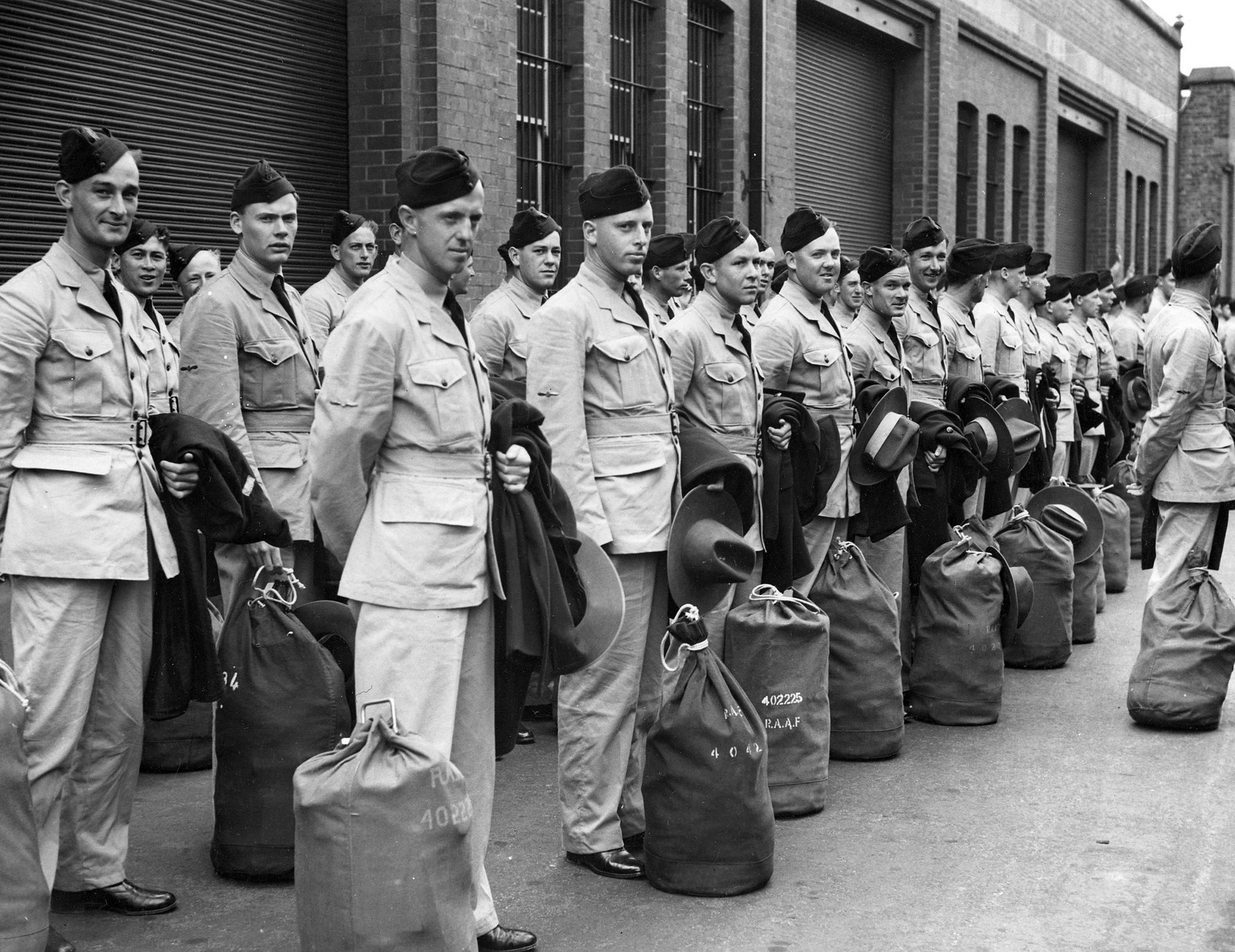
R.A.A.F. men preparing to embark to Canada from Sydney for further pilot training under the Empire Air Training Scheme, circa 1941 - Image No: FL15581995 courtesy State Library of Victoria
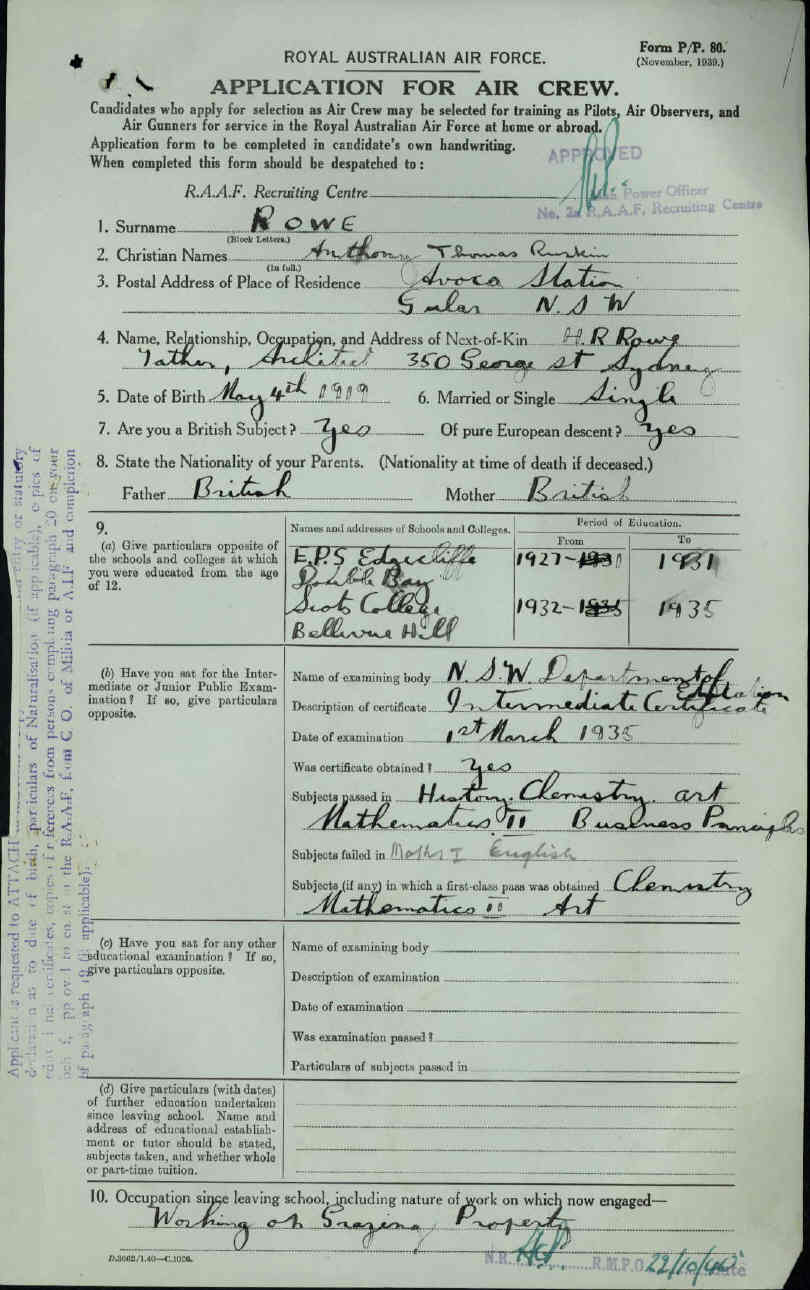
His father, Harry Ruskin Rowe, and his grandfather, Thomas Rowe, had served in one capacity or another in Engineer Corps before him and he was a cadet while at school.
Lieutenant H. Ruskin Rowe, Corps of Australian Engineers, has been promoted to the rank of captain, to command the No. 2 field troop attached to the 2nd Brigade of Light Horse. MILITARY. (1911, September 1). The Sydney Morning Herald(NSW : 1842 - 1954), p. 7. Retrieved from http://nla.gov.au/nla.news-article15270721
His father had enlisted for WWI:
COL. (ARCHITECT) SPAIN, V.D. Off to the Front
Colonel Spain, V.D., one of Australia's' best known and popular architect's is leaving: for the front this week. He has long been endeavoring to get away and take the most active part possible in the great struggle, and is naturally much gratified at the arrival of his opportunity.
At the beginning of the war Colonel Spain was placed in charge of the Engineers' Depot at Moore Park, and until a few months ago he supervised the training of our engineers for the front. He left behind him a fine record of efficient administration and his popularity was none the less among all ranks for all his thoroughness of supervision. .
Colonel Spain has had a most distinguished career in the military service, passing through all grades to his present rank, and his V.D. , after years of faithful service, was well merited.
In the building of Sydney, Colonel Spain has taken a very prominent part. The tallest building in this city, Culwulla Chambers, arose under his supervision, and is likely to long continue as Sydney's highest structure because of the legislation passed since its erection restricting the height of buildings. Other great works to the credit of his firm are Bernard's Building, in George Street, the second highest building in the city; Scott Henderson's, in Loftus Street; the offices of the Intercolonial Investment Company, Castlereagh Street; the magnificent sandstone and brick pile for the New Zealand Insurance Company, Pitt Street; the warehouse premises of J. F. Utz and Co., Kent Street; and Pratten Bros., printing establishment. Jamieson-street.
Colonel Spain has also been associated with the erection of other fine structures, including the Centenary Hall (now Sargood's) Leitch House, the Park Davis building and Gardiner and Co's., York Street.
It is interesting to note that, accompanying Colonel Spain as Adjutant, will be Captain H. Ruskin Rowe, of the firm of Ross and Rowe, architects, of this city. Captain Rowe served his apprenticeship in Colonel Spain's office and his father, the late Colonel Rowe, was a partner of Colonel Spain many years ago.
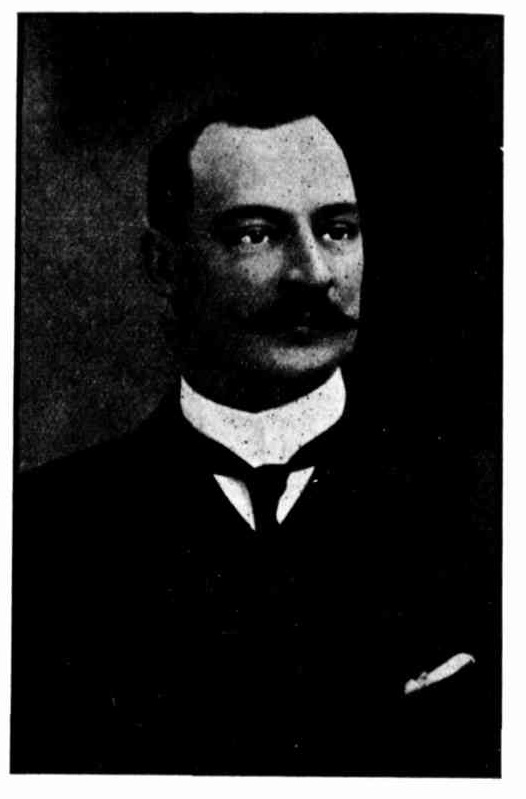
LIEUT.-COL. SPAIN V.D.A Foremost Sydney Architect, leaving, shortly for the Front
SYDNEY'S HIGHEST BUILDING Spain, Cosh and Dodds, Architects Robert Wall and Sons, Master Builders , ILLUSTRATED COL. (ARCHITECT) SPAIN, V.D. (1916, November 13).Construction and Local Government Journal (NSW : 1913 - 1930), p. 6. Retrieved from http://nla.gov.au/nla.news-article109634787
Described as 5 feet 9 ½ inches tall – fair hair, grey eyes, Anthony Ruskin Rowe trained at Temora and then Bradfield before heleft Sydney on the 18th of September 1941 and disembarked at San Francisco on the 7th of October, Canada bound. At the end of that month his engagement was announced:
ENGAGEMENT
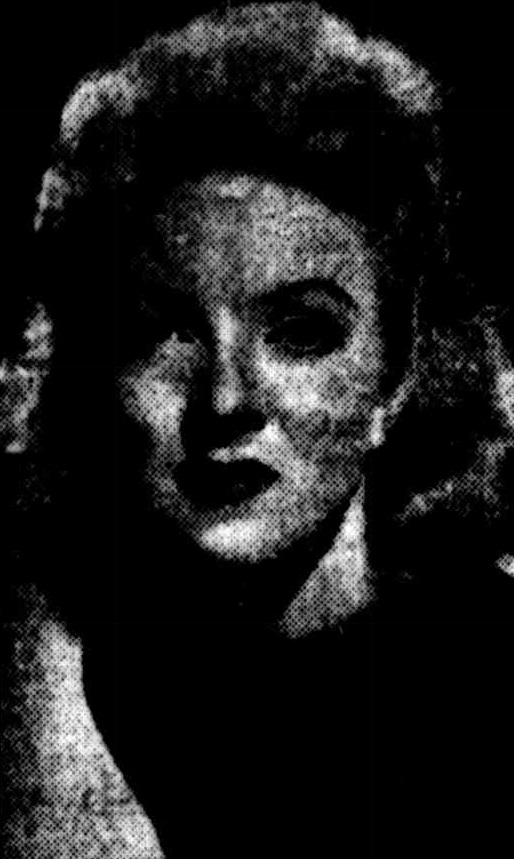
—John Lee
MISS ENID RICHMOND BOARD, only daughter of the late Mr. Leslie Richmond Board and of Mrs. Board of Bellevue Hill, whose engagement to Leading - Aircraftman Anthony Thomas Ruskin Rowe, R.A.A.F., abroad, of Wonbobbie Station, Warren, eldest son of Mr. and Mrs. H. Ruskin Rowe, of Double Bay, is announced. ENGAGEMENT. (1941, October 30). The Sydney Morning Herald (NSW : 1842 - 1954), p. 5. Retrieved from http://nla.gov.au/nla.news-article17771446
He was still in Canada when this news became available:
DEATH OF MISS ENID BOARD
Mrs. Leslie R. Board, of Bellevue Hill, has been informed that her daughter, Miss Enid Board, was killed by enemy action on December 9, 200 miles off Hawaii, while travelling between Suva and Vancouver.
Miss Board was one of two women who were shelled by a Japanese submarine while they were with others, in an outswung lifeboat from the steamer Donerail. Only seven members of the crew and passengers were saved.
Miss Board was on her way to Canada to marry Leading-Aircraft-man Anthony Thomas Ruskin Rowe, R.A.A.F., of Wonbobbie Station, Warren, eldest son of Mr. and Mrs. H. Ruskin Rowe, of Double Bay. Their engagement was announced on October 30, 1941, and Miss Board left Australia on November 5. DEATH OF MISS ENID BOARD. (1942, March 25). The Sydney Morning Herald (NSW : 1842 - 1954), p. 6. Retrieved from http://nla.gov.au/nla.news-article17794070
The MV Donerail was formerly the Danish Nordhval. She was built in 1924 by Burmeister & Wain's of Copenhagen, Denmark, was 4473 gross tons, with a length of 380 feet, nearly 54 feet wide and ran on twin screw deisel engines at 11 knots. She was one of many foreign ships taken over by the U.S. Maritime Commission in 1941, placed under Panama flag, and named after famous horses. The Donerail was sailing from Suva, Fiji to Vancouver, Canada.
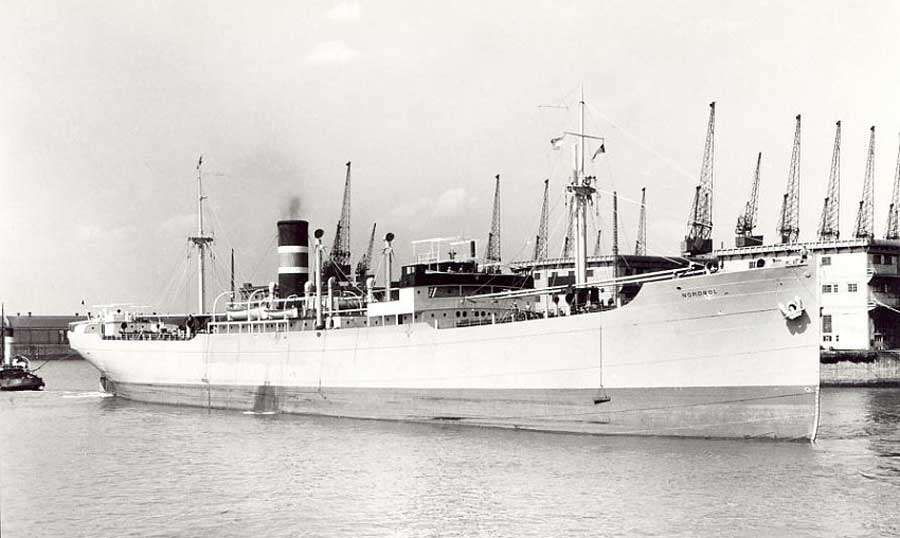
She was shelled on December 9th, 1941 - two days after the attack on Pearl Harbour - and was unarmed at the time.
The submarine which shelled her was a New Junsen Type A1 submarine laid down in January 1939 and completed in October 31st, 1941. Displacement 2,919 tons surfaced, length 373 feet, 2 diesel engines, 12,400 horsepower with a rated speed of 23.5 knots surfaced, 8 knots submerged, with cruising range of 16,000 miles at 16 knots surfaced, and 60 miles at 3 knots submerged.
The American Merchant Marine at War, www.usmm.org, website states the submarine was almost rammed by the steamer while on the surface. Enid Board was one of four Australians killed. The American Merchant Marine at War webpage on the Donerail lists them all.
38-DAY VOYAGE.
SHELLED BY SUBMARINE.
Twenty-four People Killed.
SUVA, March 18.--
The story of great hardships on a 38-day voyage in an open lifeboat was told today by survivors of the steamer Donerail which was sunk 200 miles from Hawaii two days after the raid on Pearl Harbour The Donerall was bound from Suva to Vancouver and nearly rammed a submarine on the surface at 9 o'clock at night. The submarine crash-dived and later came to the surface and shelled the boatdeck, a torpedo missing. Twenty four out of 42 on board were killed by seven shells.
Passengers, comprising two women, five men and, an 18 months' old child, were killed outright while sitting in a swungout lifeboat which was hit by a shell. Chambers, of Sydney, a member of the crew, was the only survivor of this boat of 24. The remainder of the crew got away in a badly holed steel lifeboat which sank to the gunwales, the airtanks keeping the craft awash. The castaways worked two days, stuffing the holes with clothing to gain freeboard, and battled with a gale for a week in trying to make Hawaii, but they abandoned the attempt owing to the weather and made for Tarawa where they landed after sailing about 2.000 miles.
The food and water In the boat was ruined by immersion so the survivors existed on flying fish, salt water soaked biscuits, vitamin tablets and tinned milk. Water was caught in the sails from the constant rain. Heavy gales were experienced throughout and the captain was washed overboard and drowned. Sixteen others died of exposure and starvation. Only seven reached land. All were Danes with the exception of Chambers. The mate was the only officer saved.
The Japanese had already landed and left Tarawa before the arrival of the castaways, but another party arrived while they were there. Chambers and an officer from another ship and a Tarawa civilian set out in a lagoon boat with the intention of making for Fiji, but landed at Nanouti where they found the rest of the party from the Donerail, who had come on by motor boat.
"It was a risky trip in the lagoon boat," said Chambers, "but better than a lifeboat, as we were able to land at islands en route for food and water."
Another story of lengthy voyaging in a small boat was told by survivors of the Prusa, which was torpedoed without warning in the early morning near Hawaii. Ten - men were killed by the explosion and 24 escaped in two lifeboats One boat had not been heard of since. One man died in the other boat and 11 survived after 31 days at sea and sailing 2,500 miles to land in the Gilbert Group. The party had plenty of food and water, but extremely bad weather was experienced throughout. 38-DAY VOYAGE. (1942, March 19). The West Australian (Perth, WA : 1879 - 1954), p. 3. Retrieved from http://nla.gov.au/nla.news-article47185313
On July 21st, 1942 he became part of No 131 Squadron RAF which initially had a number of Belgian pilots and was formed at RAF Ouston, Northumberland, UK. When operational the squadron engaged in fighter sweeps over Europe and later moved to India in 1944. He went on sorties over France in a Spitfire between July and November 1942.
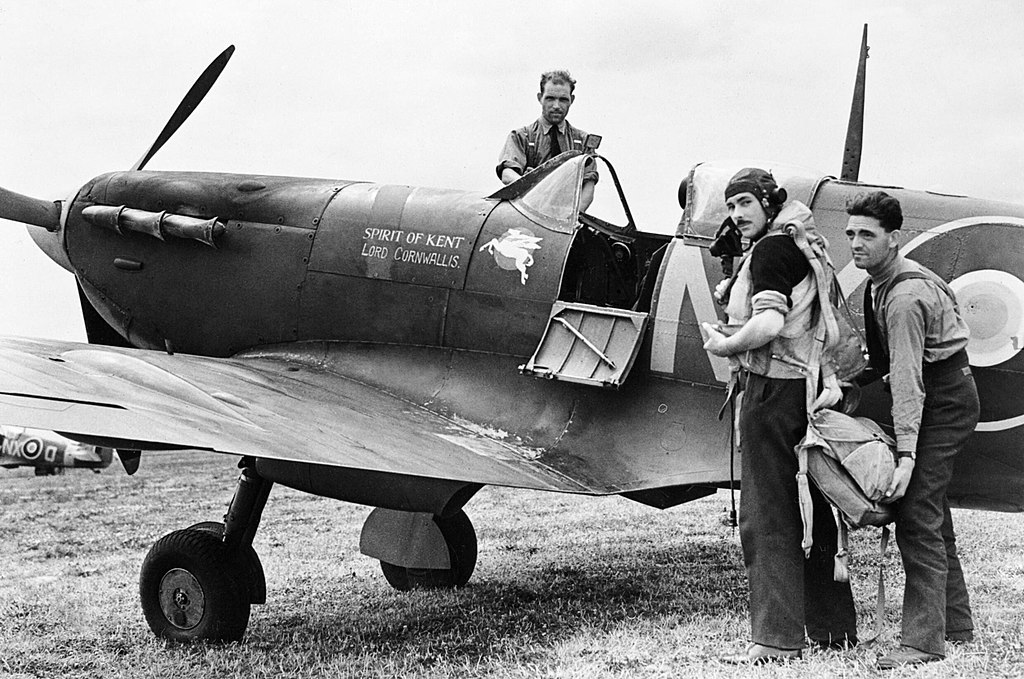
Squadron Leader M.G.F. Pedley, the CO of No. 131 Squadron RAF, about to set out on a sweep in his Supermarine Spitfire Mk VB from Merston, a satellite airfield of Tangmere in Sussex, June 1942. Image forms part of the collection of the Imperial War Museums.
He applied to come home, requesting a transfer on August 15th, 1942 - which was initially refused:
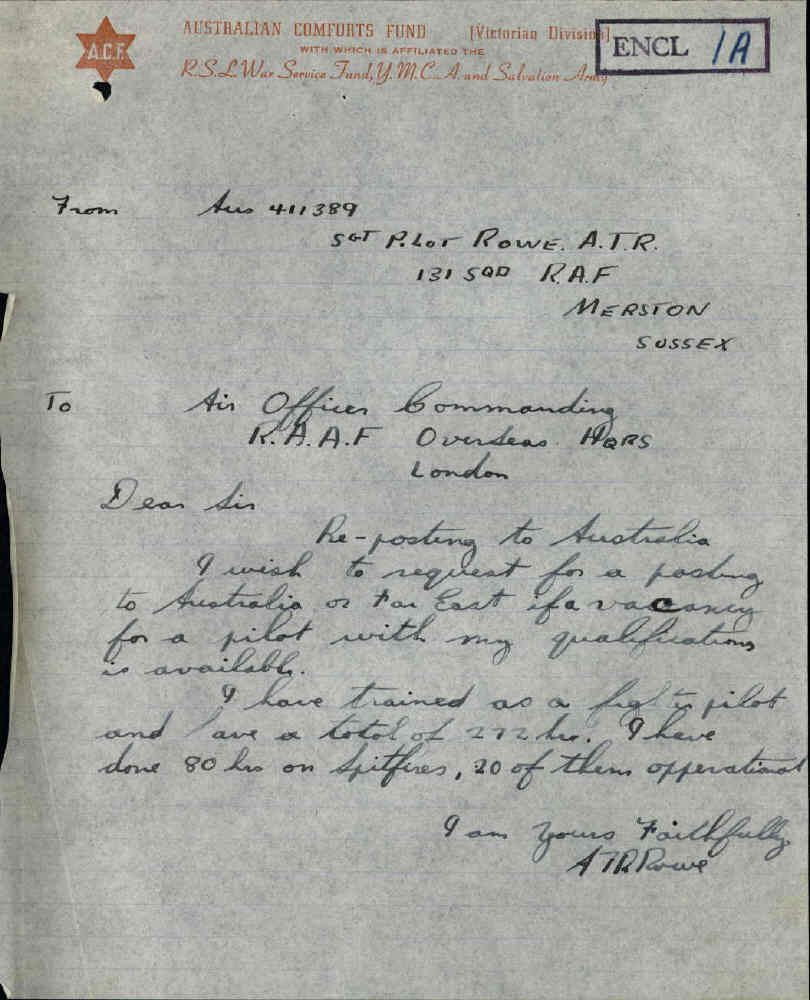
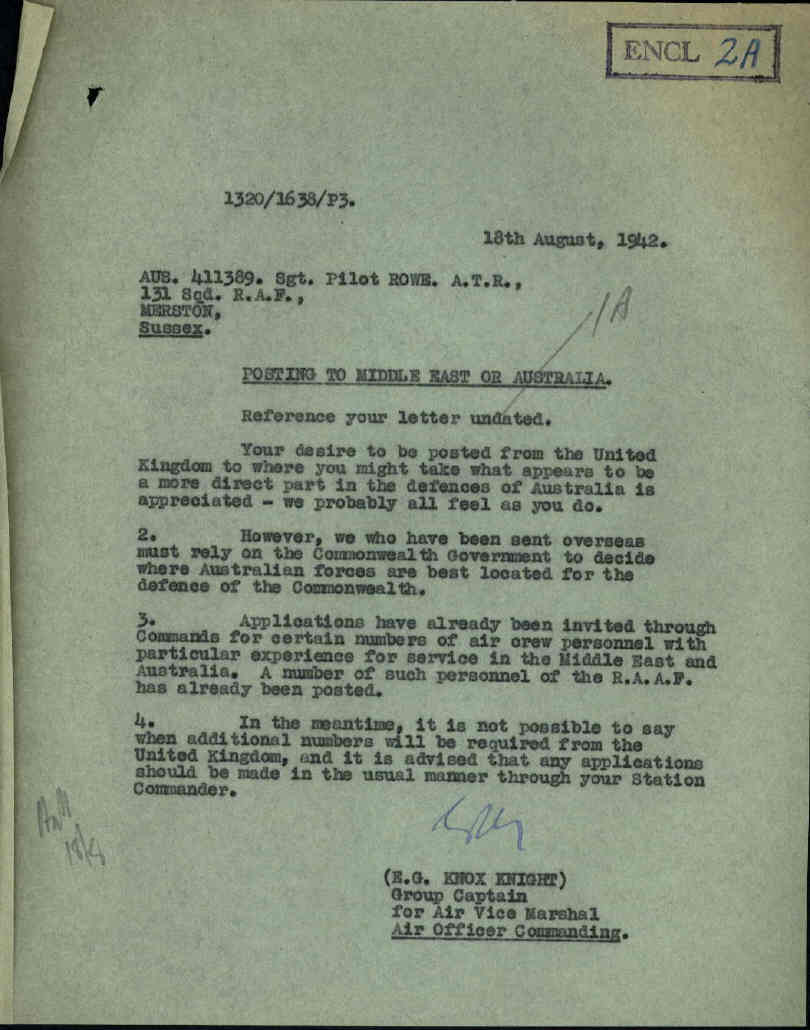
Anthony's determination to come home can be read in this letter of November, 1942:
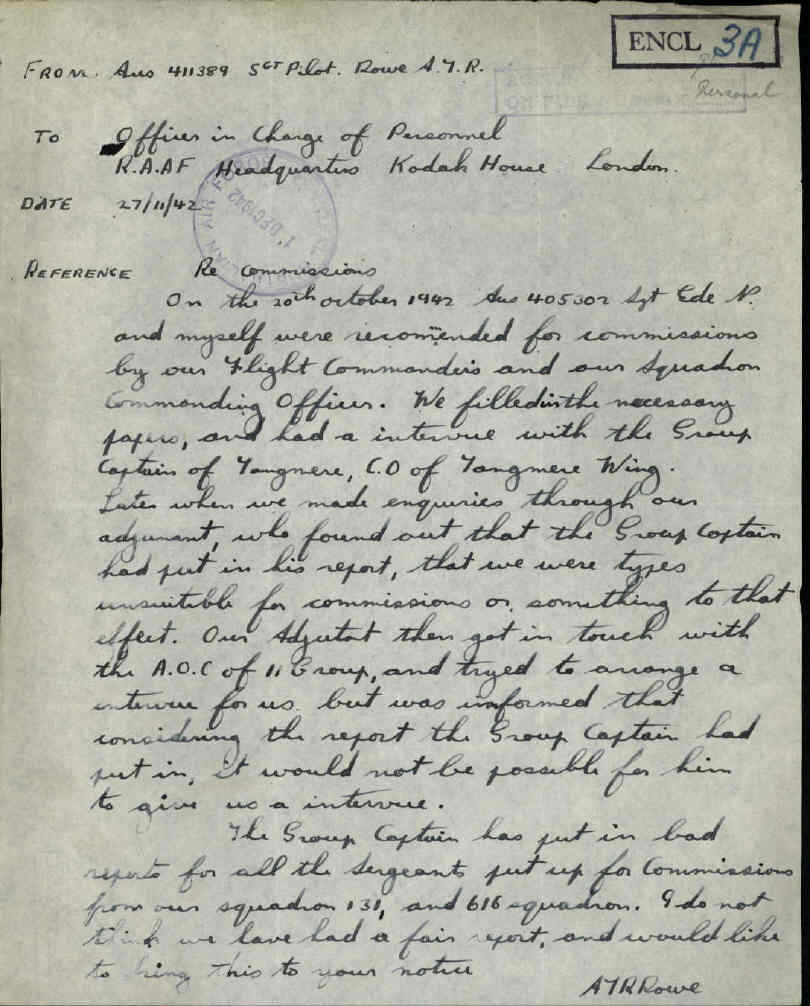
He embarked to return to Australia on December 2nd, 1942:
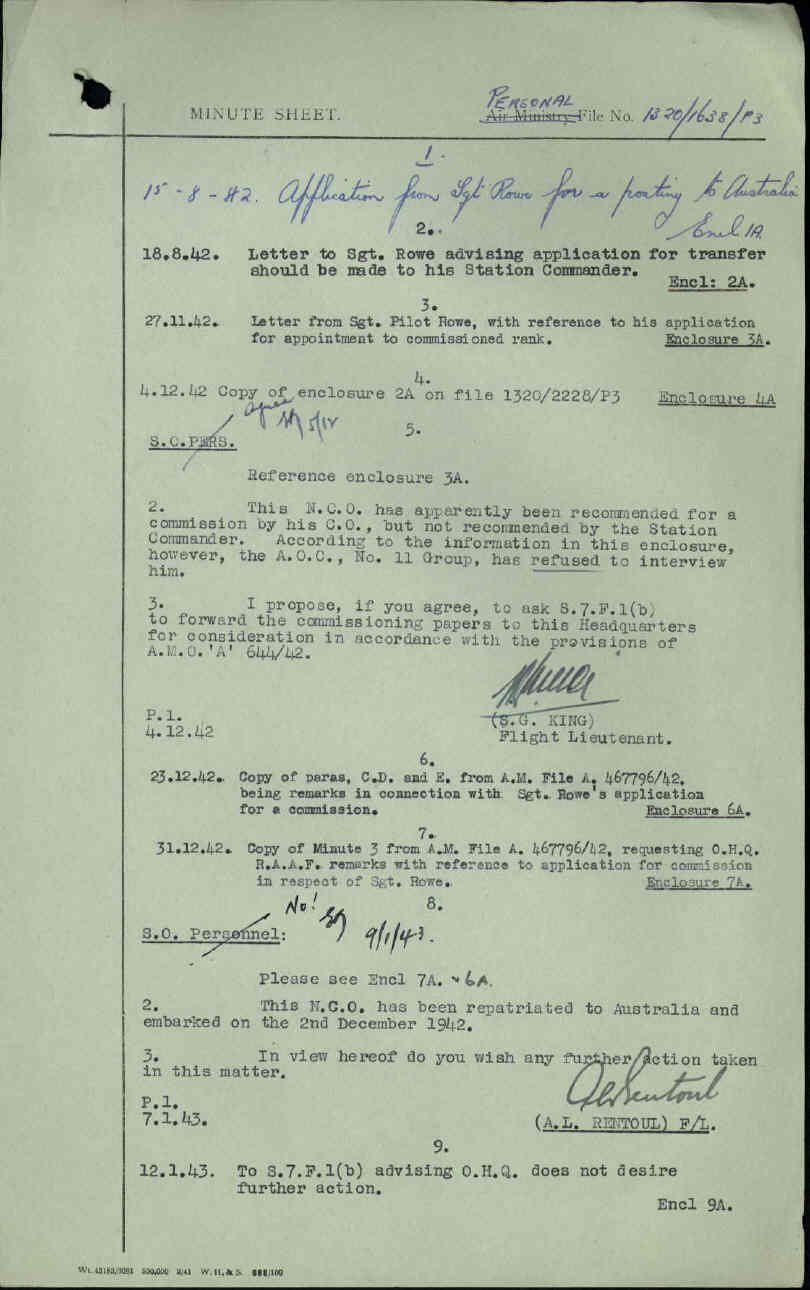
Fellow pilot Ross Richardson said of him:
“we met on board the Queen Elizabeth en route from Glasgow to Halifax, Canada. We became good friends and spent three weeks in New York with a generous couple in their Park Avenue apartment. Tony and I shared a cabin on the trip from New York to Melbourne and were posted to 452 Squadron in April 1943”
In New York, in 1940, at her own initiative, Actress and Broadcaster Nola Luxford sought permission from the Rockefeller family to establish an Anzac garden on top of the British building in the Rockefeller Center to commemorate the Australian and New Zealand war dead. The garden was formally opened by New Zealand's prime minister, Peter Fraser, in 1941. (Memorial services continue to be held there each Anzac Day.)
By now, hundreds of young Australians and New Zealanders were training as pilots and navigators in Canada under the Empire Air Training Scheme. When given final leave, they headed straight for New York and Nola's apartment. When the trickle of young men turned into hundreds each week, she decided to set up a club. Within a few months she had organised the free lease of a room in the Phi Gamma Delta Clubhouse, a gentlemen's club at 106 West 56th Street, and rounded up a group of volunteer helpers. This was the start of the Anzac Club. By the end of the war some 35,000 men had enjoyed its hospitality.
For four years Nola Luxford and her 100 mainly women volunteers worked 15-hour days to ensure each man registered at the club had a memorable visit to the city. Five hundred families in the greater New York area hosted the Anzacs for dinner or a weekend's stay. Luxford arranged cheap accommodation and meals, concerts, parties, theatre tickets, tours of the city and weekend picnics. She did all her own fund-raising.
The club became so well known that people like Eleanor Roosevelt, Gertrude Lawrence, Gracie Fields, Vera Lynn and Tallulah Bankhead dropped by. Among its patrons were prominent lawyers, bankers, doctors and philanthropists. The New York news media lionised Nola, calling her the 'Angel of the Anzacs'. She was appointed an honorary OBE and awarded the American Award of Merit (both in 1947), as well as many lesser awards and citations. In 1989 she was awarded the Queen's Service Medal by the New Zealand government.
After the war, Nola Luxford became fashion director for the exclusive Hotel Pierre in New York. Here she organised international society fashion events and raised considerable funds for charity. She published a children's book, Kerry Kangaroo, and in the 1950s lectured widely throughout the United States on peace and the islands of the South Pacific.
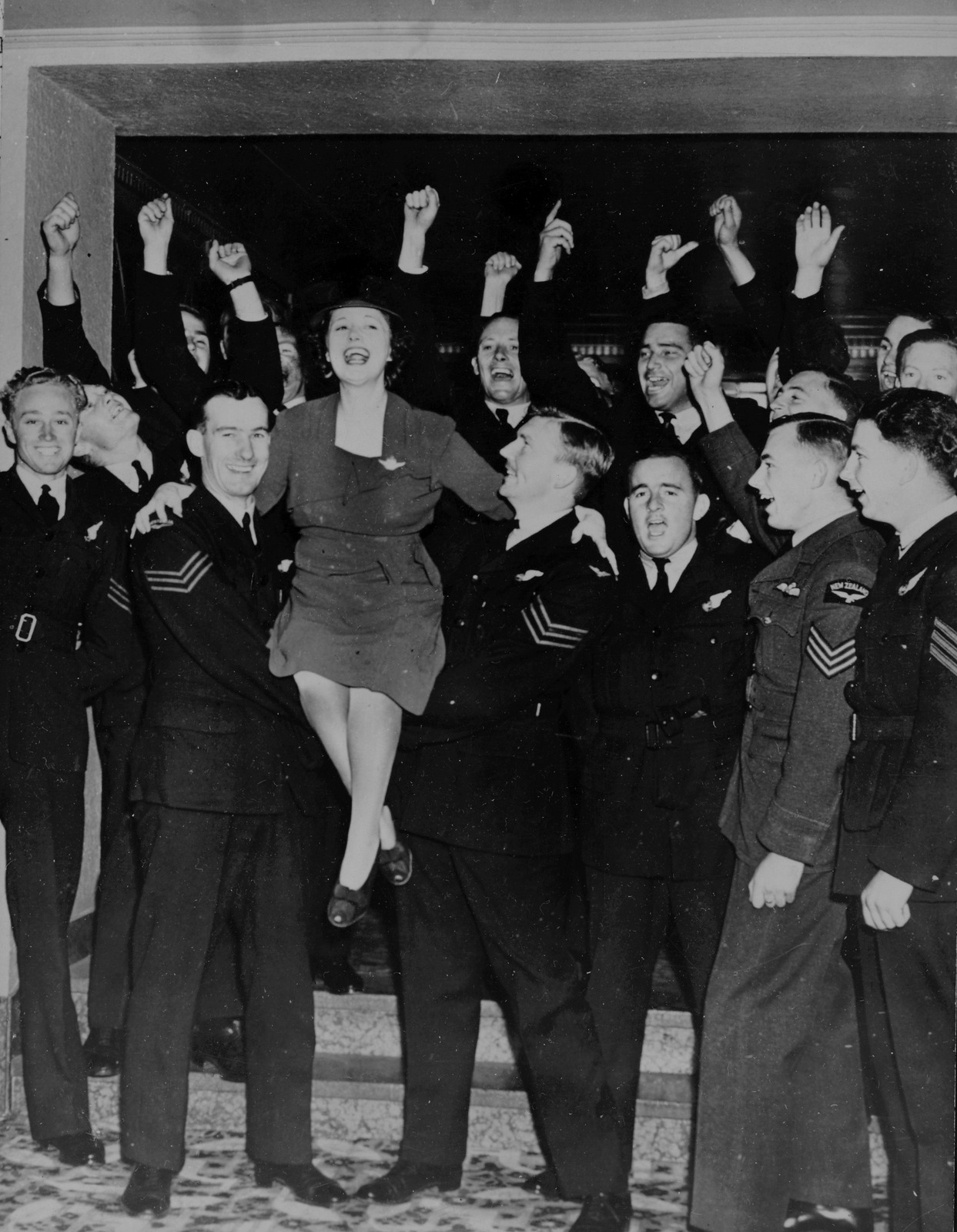
Title: Sweetheart of the R.A.A.F. [picture], courtesy The Argus, circa 1942-1943. Image: FL15765533, courtesy State Library of Victoria
When Anthony was part of the No 452 RAAF squadron it was based at Strauss Airfield, near Darwin.
From Wikipedia:
No. 452 Squadron RAAF was formed at RAF Kirton-in-Lindsey on 8 April 1941 under Article XV of the Empire Air Training Scheme; it was the the first Australian squadron formed in Britain during the Second World War. On 22 May, the squadron became operational as a fighter squadron flying early model Supermarine Spitfires. In July, the squadron was moved to RAF Kenley, where they became part of No. 11 Group RAF.
No. 452 Squadron rapidly developed a formidable reputation in operations against German forces; in one month the squadron was credited with shooting down 22 German Bf-109 fighters. They were involved in many different kinds of operations, including offensive patrols, convoy escort and bomber escort missions over Europe. One of the most unusual came on 19 August 1941, when the Kenley Wing – along with others – was tasked with escorting a formation that included a Blenheim bomber that—with the co-operation of the Germans—dropped an artificial leg by parachute into Europe, for the use of the British ace Douglas Bader, who was a prisoner of war. The bombers then flew on to bomb the Gosnay power plant. In the dogfighting the took place during the operation, No. 452 Squadron was heavily engaged, shooting down one aircraft and scoring "probable" victories over two others, but also having several of its aircraft damaged.
Another notable operation was the attack on the German warships Scharnhorst, Prinz Eugen and Gneisenau which were attempting the "Channel Dash" from their French harbour on 11 February 1942, damaging one of the escorting destroyers. One of the squadron's best known pilots during this time was Keith "Bluey" Truscott, who was credited with 16 aerial victories between April 1941 and March 1942, and was awarded the Distinguished Flying Cross (DFC) while serving with No. 452 Squadron in Britain. Although it was an RAAF unit, while it was in Europe, No. 452 Squadron also had some British personnel, from the Royal Air Force as well as other British Commonwealth air forces and other nationalities. One of these was the Irish ace Paddy Finucane. A number of Polish pilots also flew with the squadron.
The squadron moved to RAF Redhill in October 1941, remaining there until March 1942, when No. 452 Squadron replaced its sister, No. 457 Squadron, at RAF Andreas, Isle of Man, where it remained until it withdrew from operations in Britain in June of that year to return to Australia. Its final aerial victory came that month and the squadron's final tally in Europe was 70 enemy aircraft shot down and 17 damaged, for the loss of 22 pilots killed. It sailed for home on 21 June, arriving in Melbourne on 13 August and re-assembled at RAAF Base Richmond, New South Wales on 6 September. The squadron began a refresher training at Richmond, using a varied collection of aircraft because its Spitfires had been commandeered in transit by the Royal Air Force in the Middle East.
No. 452 Squadron became operational again on 17 January 1943, having received Spitfire MK Vc aircraft in October the previous year. Based at Batchelor Airfield in the Northern Territory it became part of No. 1 Wing RAAF, which defended Darwin from Japanese air raids.
The squadron was relocated to Strauss Airfield on February 1st and, with the exception of a brief period between 9 and 27 March 1943 when it was deployed to RAAF Base Pearce to reinforce the air defences of Perth, it remained there (Strauss Airfield), protecting Darwin, until 30 June 1944, in May 1944 having become part of No. 80 Wing RAAF. The previous April, the squadron had received more advanced Mark VIII Spitfire. Throughout this period, the squadron was involved in several significant actions in which it shot down a number Japanese aircraft, with its first large-scale battle coming in early March.
On 1 July 1944 the squadron relocated again, this time to Sattler Airfield in the Northern Territory. Responsibility for defending Darwin had been handed over to two Royal Air Force squadrons, as a result, No. 452 Squadron was re-assigned undertake ground attack missions. The squadron began attacking targets in the Dutch East Indies; on 11 December 1944 it was sent to Morotai, where it was assigned to the 1st Tactical Air Force, to support the Australian operations in Kalimantan, flying mainly ground attack missions and anti-shipping strikes. The ground staff were sent to Juwata airfield on Tarakan in May 1945; however, operations did not start immediately as the landing field was not ready. Operations were undertaken against Kelabaken and Simalumong on 2 July; further attacks occurred on Tawoa on 10 July. A detachment of the squadron's Spitfires moved to Balikpapan on 15 July, and began operations to support Australian troops there. They remainded there until the end of the war, flying their last sortie on 10 August 1945; its final aerial victory of the war came on 24 July when a Japanese bomber was shot down in a night-time raid over Balikpapan.
Operations continued after the war, albeit limited to defensive duties only. In October, No. 452 Squadron's aircraft were returned to Australia and it disbanded at Tarakan on 17 November 1945. Australian casualties amongst the squadron's personnel during the war amounted to 49 killed.
No. 452 Squadron was re-raised as an air traffic control unit on 16 February 2011. It forms part of No. 44 Wing and is headquartered at RAAF Base Darwin. It maintains subordinate flights at RAAF Base Darwin, RAAF Base Tindal, RAAF Base Amberley, RAAF Base Townsville and the Oakey Army Aviation Centre which provide air traffic control for these bases
Strauss Airfield was an airfield constructed between 19 March to 27 April 1942 near Noonamah, Northern Territory, Australia during World War II. It was also known as 27 Mile Field or Humpty Doo Strip.
Constructed by sections of the United States Army 808th Engineer Aviation Battalion, they built a single runway of 5,000 × 100 ft (1,524 × 30 m) wide with associated taxiways and dispersals.
The airfield was officially dedicated as Strauss Field in memory and honour of United States Captain Allison W. Strauss who was killed piloting a P-40 Kittyhawk from the 8th Pursuit Squadron ("The Blacksheep") of the 49th Fighter Group after crashing into Darwin harbour during a Japanese air raid on the Darwin RAAF airfield on April 27th, 1942.
%20,%20Tony%202nd%20from%20left.jpg?timestamp=1595303345435)
Group returning from fight over Darwin, Tony is 2nd from left - photo courtesy AWM, ABHS and Neil and Jenny Anderson - family of A T Ruskin Rowe
June 1943
On information received the previous day of an enemy concentration in Timor, the Squadron went on readiness at 08.00. At 09.50, on June 20th, 1943 news of the enemy’s approach was received (Raid No.55) and six Spitfires led by F/L Hall took off five minutes later.
A large formation of enemy aircraft were sighted at 24,000 feet. They attacked the Japanese fighters. During the raid the Squadron claimed 4 probables and 3 damaged enemy aircraft before they reached their target
F/Sgt. ROWE was flying Spitfire BS174 as No. 2 to F/O BISLEY. Just after a first attack on a bomber led by F/O BISLEY, and the immediate evasive actions that followed, it seems that F/Sgt ROWE was seen alone over Koolpinyah Station, N.T.
It was not known then if he had been hit by bombers gunners or shot down by Japanese Fighters.
He was engaged in the combat of 20th June 1943, described by one of the 54 Squadron RAF men as “their worst experience yet, even during the raids back home.” Enemy losses were nine bombers and five fighters destroyed, and ten damaged.
General MacArthur sent congratulations. Sadly 452 lost two pilots, both aged 23. P/O’s W. Nichterlean and A.T Ruskin-Rowe.
Spitfire BS174 arrived in Australia on SS Hoperidge 23/10/42. Rec 1AD ex UK 02/11/42.Rec 1FW ex 1AD 10/11/42. Rec 452 Sqn RAAF ex 1FW 11/11/42. Coded QY-W. Rec 7RSU ex 452 Sqn RAAF 24/05/43. Rec 457Sqn RAAF ex 7RSU 09/06/43. Operational loss, as Troppo Blue 2, on interception of enemy Lily Bomber and Zeke escort raid, 55, 0950 hrs 20/06/43 by 46 Spitfires of 1FW.
Troppo Blue Section of "B"Flight was tasked to intercept the bombers at 22000 feet 10 miles north of Cape Hotham. Last seen by Blue 1, F/O J Bisley DFC Serv: 402720, 1041Hrs, with Blue 2 attacking a bomber. Assumed Blue 2 was shot down by bomber own guns or by a escorting Zeke. Pilot; F/Sgt A.T.R. Rowe Serv: 411389 missing.
On 15/07/43, aircraft located. Ground party led by F/O Pollard located wreck with the help of local Aborigines, a few miles inland from Hope Inlet on the 11/07/43 near Koolpinyah Station, NT. Aircraft was burned, and had pilot still strapped in cockpit. Head Bullet wounds suggested that he was shot down by the gunner of the Japanese Bomber. When the surviving cine gun film was developed, it showed that he probably destroyed the bomber he was attacking. AMSE Approval Min#11 13/08/43 to convert to components.
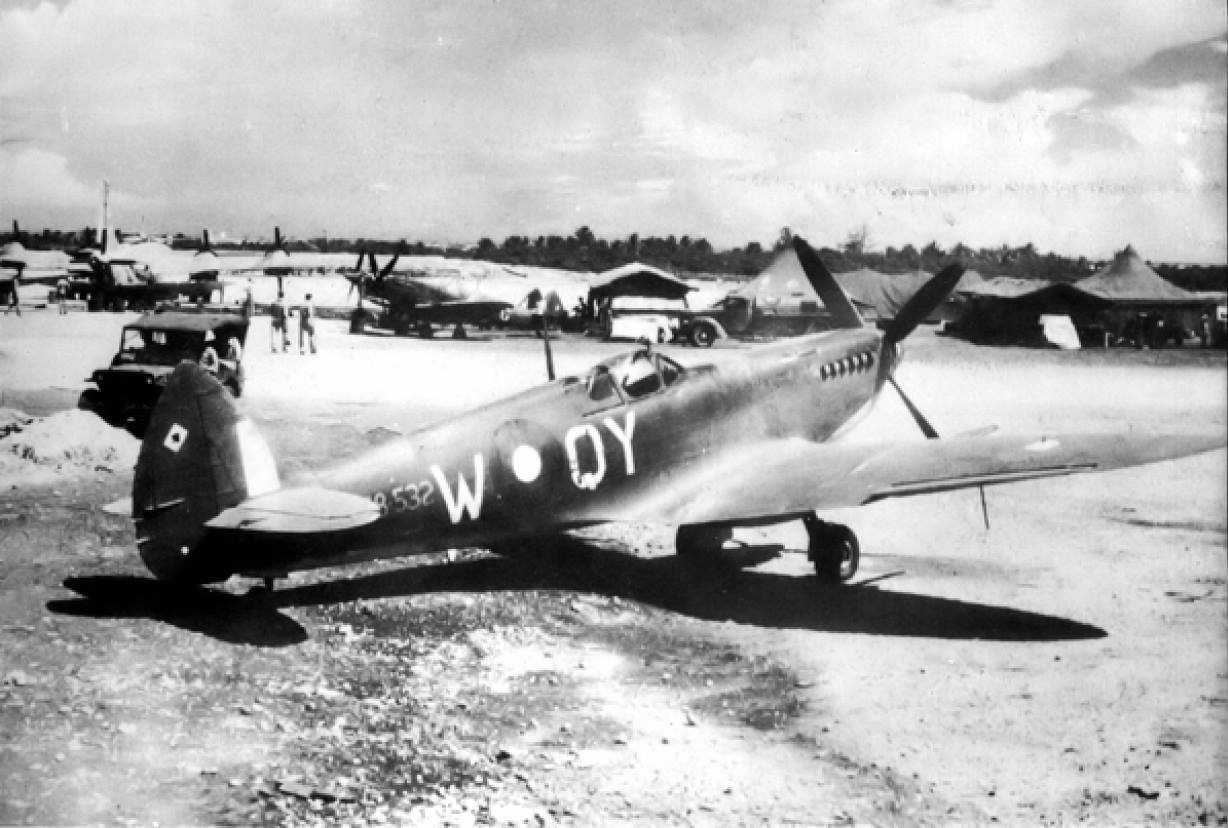
452 Sqn. at dispersal on Morotai - Photo RAAF via Kas Grigonis.
ROLL OF HONOUR
ROWE. - Anthony Thomas Ruskin, late WONBOBBIE STATION, WARREN. Spitfire pilot, RAAF died fighting north of Australia 20th June, 1943. Late 121st Channel Fighter Squadron RAF. Dearly beloved elder son of Mr and Mrs H. Ruskin Rowe, Double Bay and brother of Joyce and Beresford. Aged 23 years. Family Notices. (1943, July 21). The Sydney Morning Herald(NSW : 1842 - 1954), p. 12. Retrieved from http://nla.gov.au/nla.news-article17857144
KILLED IN ACTION. PILOT OFFICER "TONY" ROWE
Deep regret was expressed in Western circles when it became known that Pilot Officer Anthony Thomas Ruskin("Tony") Rowe, son of Mr. H. Ruskin Rowe, of Wonbobbie Station, Warren, and Mrs. Rowe, of Double Bay, had met his death in sad circumstances,
This bright young airman, who was only 23 years of age, had been missing for three weeks and when found dead it was learned that be had been shot up badly after attacking 48 Japanese plane's, of which he shot down two bomber’s and one Zero. This fact was revealed when the film of his camera gun was developed by the Intelligence' Department of the R.A.A.F. It would appear he was killed trying to save his mate, who was not quite so experienced a pilot or fighter. Both we're killed, but it is some consolation to the bereaved families to know that 12 Jap bombers and six Zeroes did not get home.
The late Pilot Officer Rowe was very well and favorably known throughout Warren and surrounding districts, having been manager of Wonbobbie Station at the time of his, enlistment.
At the early age of 18 years he took over the management of Avoca Station, in the Gulargambone district. He was a grandson of the late Mr. Moore Council, of Gulargambone, who came up from Wallangarra and took up Avoca Station now owned by Mrs. H. Ruskin Rowe. He was one of the pioneers of that district, Avoca at the time being a very big property, and was one of the greatest, advocates for the extension of the railway from Nevertire to Warren, Nevertire those days being the nearest rail centre to Avoca.
Prior to returning to Australia, the late Pilot Officer Rowe was a member of the Channel Fighting Squadron, R.A.F., and had taken part in many outstanding flights, being particularly mentioned by his Commanding Officer for skilful flying in actions over Dieppe, in Germany. The remains were buried at Adelaide River cemetery, Darwin. Besides the sorrowing parents, a sister (Joyce) and brother(Beresford) are left to mourn the passing of a brave soldier. KILLED IN ACTION. (1943, August 26). Gilgandra Weekly(NSW : 1942 - 1955), p. 3. Retrieved from http://nla.gov.au/nla.news-article113240305
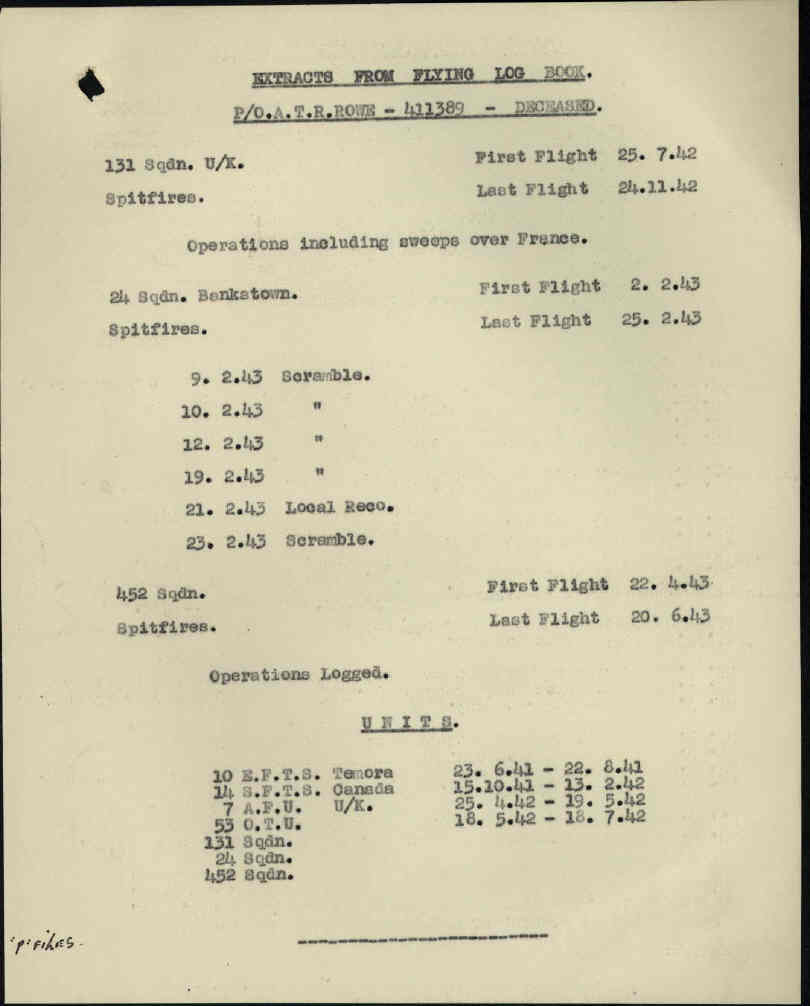
Avalon Beach SLSC member during WWII Reg Woods recalls Anthony's father here during that conflict, during his 2014 interview he said:
There was a chap called Ruskin Rowe, a big architect down there, and he had a lot of land down there – most people would know what has been named after him – Ruskin Rowe. He was a big chap, great big chap, we used to see him of a morning in white shorts, a white sailcloth hat with the side turned up, and he had a great big Cadillac – he used to go down to the milk shop at Wilco’s with this little tiny bloody milk can and get his milk. It looked so funny, this huge man getting out of his car with this little can getting his milk (laughs).
He was a huge man, nice man, well spoken. At any rate, he used to go up there to his land, he had all this land there and during the war he had the Air Force Cadets in – he used to get up there with a big scythe and get them to use the scythe going all over the grounds.
The Air Force Cadets would be down at Avalon for the weekend and they would march down to the beach and then they’d all go into the water. They were pretty regimented - we’d watch them march down and go back again. We knew we’d have trouble when they came down to the beach though – would say to each other ‘here they are, watch ‘em,’ – you had to watch them like hawks because some of the young scrubs were from the country and they didn’t know how to swim.
SYDNEY SHELTER PLANS.
Air raid protection plans for the Sydney city area provide for sheltering about 200,000 people. It has been estimated that about 90,000 could be sheltered in railway and tramway tunnels, and 50,000 in private buildings, such as shops and offices.
Sites have been chosen for sufficient City Council shelters to accommodate 60,000 more, but no decision to build so many shelters has yet been made. It is estimated that they would cost about £200.000. City Council shelters costing about £4,000 are now under construction. '
One of the difficulties confronting the council is that it has no definite knowledge of any plans that might have been made for evacuating people from the city in the event of enemy attack. Any decisions on this point would have an important bearing on the number of air raid shelters that would be required.
Consideration is to be given to strengthening parts of the Sydney Town Hall, to provide protection.
The Chief City Warden, Mr. A. M. Pick-ford, said last night that there had been an excellent response to the appeal to owners of city buildings to appoint building wardens and take precautions for the protection of their buildings and the occupants.
Since the distribution on Monday of 5,000 copies of the booklet containing information for the guidance of building owners a number of requests had reached his office for advice, and he had delegated to four men the task of answering inquiries personally. They had set out yesterday morning to visit the buildings from which the inquiries had come, and would continue these visits daily and give all the help possible.
The suggestion was made by Mr. H. Ruskin Rowe, a Sydney architect and engineer, who said that such a tunnel would provide a vast air raid shelter for the eastern suburbs. SYDNEY SHELTER PLANS. (1941, February 20). The Sydney Morning Herald (NSW : 1842 - 1954), p. 7. Retrieved from http://nla.gov.au/nla.news-article17731452
AIR TRAINING CORPS CAMP AT AVALON OPENED.
The R.A.A.F. Air Training Corps camp at Avalon was opened yesterday by Group-Captain W. H. Robertson, Commanding Officer for Australia of the A.T.C. The cadets receive preliminary training at the camp to prepare them for their entry into the Air Force at the age of 18.
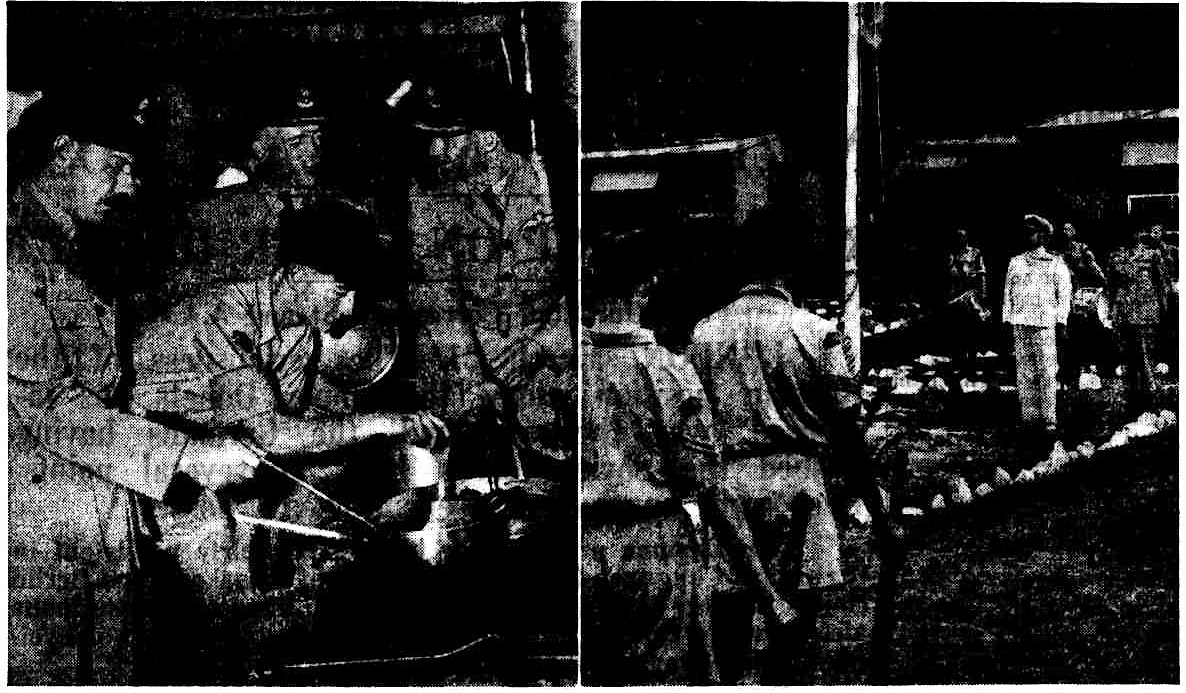
Left: Pilot-Officer Wadds', D.F.C., Group-Captain Ellis, and Group Captain Robertson with an A.T.C. corporal in the camp kitchen. Right: Rear-Admiral Muirhead-Gould speaking at the opening of the camp, which is the first of its type in Australia. AIR TRAINING CORPS CAMP AT AVALON OPENED. (1943, March 22). The Sydney Morning Herald (NSW : 1842 - 1954), p. 6. Retrieved from http://nla.gov.au/nla.news-article17841433
The honouring of those who served in our region, remembered this week during VP Day Services, has hundreds of thousands of stories of individuals who gave their lives to defend their home soil.
Anthony Ruskin Rowe gave his life to defend Darwin and to defend his mate. He came from a family who for generations had done their utmost to serve Australia, and to serve our community, even in the face of heartache and loss.
You never recover from losing a child.
When peace came again memorials to lost loved ones and looking after who and what was still here became the focus for many - Anthony's family included.
A few items found:
MEMORIAL CARILLON
Sir,-Following the letter by Mr. W. Rowe, secretary of the New South Wales Change Ringers, I would go even further than the very constructive suggestion he makes.
Having had the privilege of hearing some of the finest carillons ringing on the other side of the world. I would suggest that, when the- Federal Government proceeds to set out and construct this very fitting memorial to our dead, it employs high-grade experts of experience for the design, erection, and installation of so unusual and important a construction as our national memorial at Canberra.
As one of the originators of the first idea of embodying, carillons in a memorial, I would refer to the "Sydney Mail" of November 23, 1921, in which it will be noted that the design set forth by myself, shows the efficiently perforated belfry as recommended by the great English manufacturer of bells, John Taylor, of Loughborough.
It is very disappointing to listen to the small concert carillon in the old stone tower at the University of Sydney. This result was unfortunately brought about by not having sufficient money for ideal conditions for the housing of the bells.
Personally, I do not know of more impressive or beautiful music than that of a properly rung carillon.
H. RUSKIN-ROWE. Sydney.
MEMORIAL CARILLON. (1947, May 15). The Sydney Morning Herald (NSW : 1842 - 1954), p. 2. Retrieved from http://nla.gov.au/nla.news-article18026353
BARRENJOEY VANDALISM
Sir,-Last Sunday when proceeding from Palm Beach to Barrenjoey headland, I was shocked to see scores of the largest and most beautiful banksia trees on our coast slaughtered and hacked down apparently only during the last few days.
Many of these trees are of great age and most of them are between 2ft and 4ft in diameter They were not only very decorative but they gave shade to picnickers
On walking to the top of the headland at Barrenjoey, I was ashamed to notice that the very fine old lighthouse stone buildings are being rapidly destroyed All the glass windows are smashed and all fittings, or any particle of the building of any value not smashed up, have been taken away I understand that although, the buildings were put up in 1882 this vandalism has only occurred since the end of the war when the guard was removed
H. RUSKIN-ROWE.
Sydney.
BARRENJOEY VANDALISM (1947, May 20). The Sydney Morning Herald (NSW : 1842 - 1954), p. 2. Retrieved from http://nla.gov.au/nla.news-article18026839
BEACH VANDALISM
Sir,-Mr. H. Ruskin-Rowe has called attention to the vandalism which is destroying the waterfront and the historic lighthouse building of Barrenjoey. Unfortunately, such destruction is not limited to that area, and it is questionable whether there is one beach retaining its original beauty in any populated area. Natural growth is not only beautiful but often essential to the maintenance of the beach itself. Buildings, fences, and concreting encroaching in the place of trees and shrubs, disfigure the scene. They are ugly and ineffectual barriers, often swept away until nothing is left but flotsam and jetsam. Sandy beaches cannot be re
made. Surely the time has come for the establishment of a national trust to safe-guard all beautiful natural features and interesting places for the pride and enjoyment of future people. Our present lack of civic pride is becoming a by-word to visitors whom we invite to seethe very things we are destroying. MINARD F. CROMMELIN. Pearl Beach. BEACH VANDALISM. (1947, May 26). The Sydney Morning Herald (NSW : 1842 - 1954), p. 2. Retrieved from http://nla.gov.au/nla.news-article18027611
H. RUSKIN-ROWE, F.R.I.B.A.
News has just come through that Mr. H. Ruskin-Rowe has been unanimously elected a Fellow of the Royal Institute of British Architects.
As a student, Mr. Rowe had a record academic course at the Sydney Technical College, the only source of gaining architectural knowledge in those days, in which he won First Honours grade in every subject.
He served with the firm of Rowe and Spain, founded originally by his father. This firm later became Spain and Cosh, whose work was of a very high order.
Mr. Rowe did a considerable amount of work in Queensland, and was for seven years engaged upon work at the Sydney University where he supervised several fine stone buildings. When he was in practice with Mr. H. E. Ross—a partnership lasting twenty two years, £22,000,000 worth of work was carried out—worthwhile work, such as the Government Savings Bank, the Royal Automobile Club, a number of large city warehouses, some of the finest industrial buildings and some of the best residences in the country and in the suburbs of Sydney. During this time, never a cross word passed between the partners (Ross and Rowe).
The following is a list of some of the buildings designed and carried out when a principal of H. E. Ross & Rowe:—The Commonwealth Savings Bank, Martin Place, Sydney, and about 150 other Savings Banks; Usher's Hotel, Sydney; Rickard House, Sydney; Rofe Chambers (now Public Trustee); Wigram House; Dungowan Flats, Manly; Phillip House; Royal Automobile Club, Sydney; Nock & Kirby Limited. (Old Civil Service Store); Clyne House; General Motors, St. Peters, Sydney—including railways; Ludowici Tanneries; Extensive additions and remodelling complete, the Hotel Sydney; Mark Foys Piazza Main Warehouse, Sydney—including power plant; Sydney Ferries vehicular docks and wharves; Beard Watson's Furniture repositories and workshops; Robert Reid & Co., warehouse,- Sydney; Balmain Light and Power Station; Broken Hill Proprietary Office, Newcastle; Mangrovite Belting Company—factories; Toohey's Limited. The main grain silos and about 100 hotels; Gordon Marr & Sons, foundries; Babcock & Wilcox Limited. Boiler works, Regents Park; Bushell"s Tea, Warehouse; Tillock Company, factories; United Wire Nail, factories; Spicers & Detmold, warehouse; William Adams ii Company—warehouse and factories; Co-operate Wool Stores; Commonwealth Wool Stores; Winchcombe Carson Limited, Sydney; Eastern Telegraph House; Smith Cos Waddington, factories, Sydney; Cumberland Paper Board Mills; Rosella Preserving and Man' ufacturing Company, Rosebery; R.A.S. Members" Grand Stand; Castlereagh House; Lassetters Buildings, York Street; Ludowici House, York Street; Orange Abattoirs, railway and water works.
Since then, Mr. Rowe has carried out £4,000,' 000 or £5,000,000 worth of homes for the Government Savings Bank, and jocularly speaking, he says he "never lost a bean, never had a crack, and never had a personal scandal."
He visited these buildings to (1) inspect the foundations, (2) when the damp-course was in, (3) when the walls were up, and (4) when the roofs were on, always before breakfast.
In family life Mr. Rowe had one son, Anthony Thomas Ruskin-Rowe, who was killed during the war at Darwin, and the words that Mr. Rowe reminiscently applied to George A. Taylor, late Editor of this journal:
"Those we love never die whilst they live in the memory of. those who love them," can truly be applied now in his own son's case.
Five years of his life were spent on the land, and he came back fourteen years ago and practised in the name of "H Ruskin-Rowe," Mr. Ross having passed away several years ago before he came back.
Altogether he has had thirty-three years of station life to occupy his week-ends and holidays, and knows station life as he said, "Inside and out." Truly a picturesque career. We congratulate him upon his crowning glory. H. RUSKIN-ROWE, F.R.I.B.A. (1947, September 24). Construction (Sydney, NSW : 1938 - 1954), p. 7. Retrieved from http://nla.gov.au/nla.news-article222877586
NEW SCHOOL HALL
A contract for over £26,000 has been signed with McDonald Constructions Pty.Ltd. for the erection of a hall and library for Knox Grammar School, Wahroonga.
The building is the gift of Mr. F. R. Williams as a memorial to his eldest son, Pilot-Officer John Robert Williams, R.A.A.F., who was killed over Germany on November 6, 1944. It will be known as the John Williams Memorial Hall and Library. The building will have striking Scottish baronial features. Its massive circular tower, known in the Scottish Highlands as a pepperpot tower, is characteristic of the old baronial castles of Scotland, and so are the typically Scottish crow-step gables.
SCHOOL TRADITIONS
In these respects, the design reflects the traditions and sentiments of the school, while its ecclesiastical atmosphere emphasises its memorial character.
The plans were drawn up by Old Knox ex-Servicemen from the office of Mr. H. Ruskin Rowe, architect, who is now supervising erection of the works.
Mr. Williams conceived the idea of donating the building early in 1946, and the building would have been built the following year but for Government bans under the Building Materials Control Act. As a result, the project had to wait for six years while building costs soared, with the result that Mr. Rowe finally had to make a drastic revision of the plans in order to keep costs within manageable limits.
The building will provide a greatly needed addition to the school.
The main hall, without its spacious stage, will accommodate over 1,000 people. It will have a wide and generous open terrace facing what will become a quadrangle formed by the new building, the old main school, and the new science wing. A well-lit and commodious library is located in the lower or sub-basement floor. It is expected that the work will be completed in about eight months. NEW SCHOOL HALL. (1953, August 4). The Sydney Morning Herald (NSW : 1842 - 1954), p. 8. Retrieved from http://nla.gov.au/nla.news-article18383190
The Construction newspaper clearly forgot that Mr and Mrs H. Ruskin Rowe had two other children, one a son - Beresford, who only passed away a few years ago, in May 2012, at 'Wonbobbie', Warren, aged 90 and beloved by his children and grandchildren.
The laughter of young children remains a remedy to grief. When his father passed away on February 5th 1956, at his home at 31 Ocean Street, Double Bay the following is in the Notice:
ROWE - Harry Ruskin, - February 5, 1956, at his home, 31 Ocean Avenue, Double Bay, dearly loved husband of Vera and father of Joyce, Anthony, (killed in action) and Beresford. Privately cremated February 6 1956.
The Sydney Morning Herald, of December 23rd 1972 has, for his wife:
RUSKIN-ROWE, Vera Elizabeth, - December 22, 1972, formerly of 31 Ocean Avenue, Double Bay, dearly loved wife of the late Harry Ruskin-Rowe, loved mother and mother-in-law of Beresford and Joan and fond grandmother of Jennifer, Tony and Bettina.
The list was longer for Beresford.
Extras
The Late Colonel Rowe.
On Saturday last Colonel Rowe, a worthy colonist, who has been in many ways identified with the progress of Sydney, died at Darling Point. The chief cause of his death was gastric catarrh, accelerated by an accident which happened him in a cab about six weeks ago. Colcnel Rowe was principally known as the architect of many of Sydney's finest edifices, and also in connection with the Corps of Engineers.
The following are some of the buildings designed and constructed under his supervision : —
Vickery's-buildings, Perry Brothers' and Hoffnung's warehouses, Harris and Ackman's premises and Y.M.C. A. Hall, all in Pitt-street ; the Sydney Hospital, Macquarie-street ; the Royal Arcade, Gardiner and Co's warehouse, the Jewish Synagogue, Newington College, Stanmore, the Thomas Walker Convalescent Home, and many other well-known buildings. Rowe-street was named after him in recognition of his services in municipal matters.
In military matters he became connected with the Engineers as far back as 1872, when he joined as lieutenant. After several promotions he obtained the rank of honorary colonel about five years ago, and in that capacity was popular and respected by every man in the service. Towards the end of that year Colonel Rowe invented an ingenious shovel shield designed for the protection of riflemen. In the 'Mail' of 29th October last there appeared five illustrations showing the working of the shield also descriptive letterpress of its official trial.
Colonel Rowe was founder of the Institute if Architects and its president for many years.
Colonel Rowe was appointed under the Parkes Government as president of the Metropolitan Water and Sewerage Board in the year 1888. Up to the time of his death he was a life governor of the Sydney Hospital, and chairman of the Rushcutter Bay Park trust, and was one of the two last surviving trustees.
The following general order was issued by Major Boam, D.A.A.G.:—
'The lamented death of Colonel T. Rowe, V.D., this morning removes an officer who, through his long connection with the military forces of the colony, invariably exhibited the greatest earnestness in carrying out the duties connected with his position. As a token of respect to the memory of the late Colonel Rowe, officers when in uniform are requested to wear crape above the left elbow for a period of two months.'
The military funeral on Sunday was an imposing ceremony, and the cortege was one of the largest which has been seen in Sydney. Colonel Rowe"s re- mains were borne to St. Mark's Church prior to their burial in the Waverley Cemetery. Funeral music was rendered at the services, Beethoven's and Chopin's funeral marches and the Dead March in ' Saul ' being played. A firing party of 250 men was in command of Major J. H. A. Lee, and a large and representative muster of military officers and men joined in the procession.
There were also 180 officers and men from the Board of Water and Sewerage. A very large number of well-known citizens attended at the grave, which is situated in that part of the cemetery where the remains of the late Governor, Sir Robert Duff, were interred.
Colonel Rowe was a native of Penzance, Cornwall, and he had lived in New South Wales 42 years. At the time of his death he was in his 70th year. One of our pictures gives a portrait in uniform of the late Colonel, and the other shows the funeral leaving St. Mark's Church, Darling Point, of which he was a warden, and giving prominence to the hearse, the gun-carriage, the wreaths, and Colonel Rowe's favourite charger.
.jpg?timestamp=1566026922280)
Photo, by Creelman. THE LATE COLONEL ROWE, V.D., in the uniform of Colonel of Engineers, specially taken for Captain C. Stuart-Cansdell's forthcoming ' History of the New South Wales Corps of Engineers.'
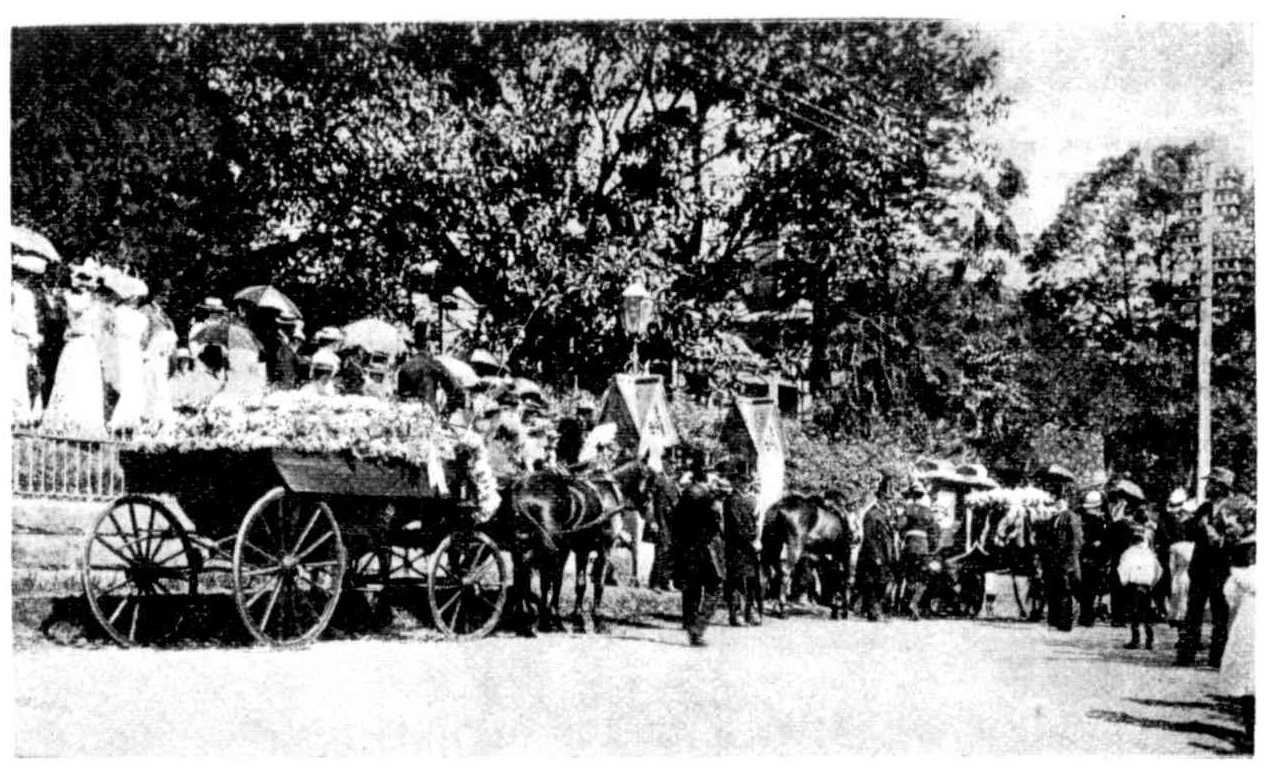
FUNERAL OF THE LATE COLONEL ROWE.
The Late Colonel Rowe. (1899, January 21). The Sydney Mail and New South Wales Advertiser (NSW : 1871 - 1912), p. 149. Retrieved from http://nla.gov.au/nla.news-article165229373
The Late Colonel Rowe.
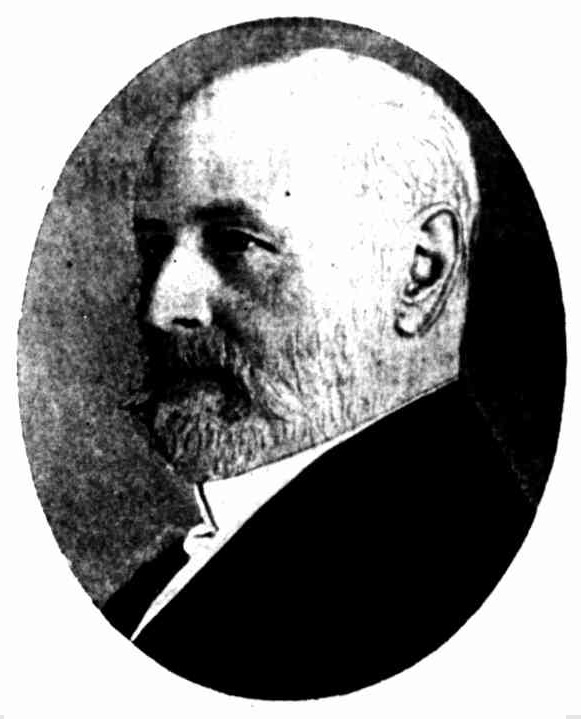
(Photo, by J. Hubert Newman, Sydney.)
Colonel Thomas Rowe, F.R.I.B.A., one of the leading architects of Sydney, and the president of the Metropolitan Board of Water Supply and Sew-age, died at about 4 o'clock on Saturday morning, at his residence, Mona, Darling Point.
Colonel Rowe, who was in his 70th year, has for many years been a prominent figure in the professional and in the public life of the colony. Born in Penzance on July 20, 1829, he was the eldest son of Mr. Richard Rowe, whose wife was a descendant of the ancient Godolphin family, who, for centuries, governed and owned by lease the Scilly Islands. His father was a builder and architect, and after passing through the Barnes Academy, the son entered his office, where, besides becoming a proficient draughtsman, he obtained an intimate knowledge of practical work, which afterwards proved invaluable in a new country like New South Wales.
In 1845 young Rowe reached this colony, and upon the outbreak of the various gold rushes he followed the life of a gold miner with considerable success. After a short period of speculative building, he started, in 1856, to practise as an architect in Sydney. His first ecclesiastical building was St. George's Church, Castlereagh-street. Structures designed by him or by the firm of Rowe and Green, of which he was principal, are now to be seen in every quarter of Sydney, and to enumerate them all would not be possible in such a brief notice as this. In Pitt-street alone he built Lord's warehouses, the Hon. E. Vickery's two handsome blocks. Perry Brothers' warehouse, the Angel Inn, the artistic stone warehouses of Messrs. H. Bull and Company (destroyed by fire in 1890), the immense premises of S. H. Hoffnung and Company, Harris and Ackman's auction rooms (on the site of the old Victoria Theatre), the George Hotel, Wright, Heaton, and Company's spacious block known as the "Commercial Buildings," the handsome edifice now occupied by the Masonic Club, Washington Soul's branch warehouse, the Royal Arcade, and the fine hall of the Young Men's Christian Association.
Among his other works are the Jewish Synagogue in Elizabeth-street, the King-street Arcade, Elliott Brothers' warehouse in O'Connell-street, Newington College, the Centenary Hall, Gardiner and Company's warehouse, York and Clarence streets, and many leading buildings in Bathurst, Goulburn, and other country towns. He also drew the plans from which Sydney Hospital was built.
In 1872 the deceased gentleman was elected alderman for Bourke Ward, which he represented in the City Council for four years. Through his agency during that period several reforms, both sanitary and economic, were worked in connection with the water supply. Rowe-street, which runs from Pitt-street to Castlereagh-street, was at that time named after him by his brother aldermen.
In 1877 he was elected first Mayor of Manly, being re-elected afterwards without opposition, and ha took a prominent part in laying out the suburb, making it the model municipality which it now is.
Mr. Rowe was the founder, and for many years president, of the New South Wales institute of Architects, and was elected a Fellow of the Royal Institute in 1884. He was the founder of the William-street Sunday School, of which he was for nearly twenty years superintendent. In military, matters he also took an active interest. Receiving a commission in the newly-formed Engineer Corps in 1872, he was promoted to the rank of captain in 1874, recommissioned captain commanding in the defence force in 1878, made major in 1880, and raised to the rank of brevet lieutenant-colonel in 1886.
During a European tour in 1887 he visited Aldershot, Chatham, Enfield, and Wodwich, in search of information relating to defence matters. Later on he designed several entrenching tools for the use of engineers corps, as well as a bullet-proof shovel, which has successfully stood severe tests. He was the founder of the Naval and Military Institute.
Last January he retired from active work in connection with military matters, but still held the full rank cf colonel. Colonel Rowe was chairman of the Rushcutters Bay Park committee. in 1888 the late Sir Henry Parkes appointed Colonel Rowe president of the Water and Sewerage Board, which he vigorously re-organised with beneficial results. He has remained in that position ever since, with the exception ' of twelve months in 1892, when Mr. C. Darley presided, Colonel Rowe then occupying a seat upon the board. The great leaps and bounds by . which the department has progressed, and its present state of efficiency, bear ample testimony to the capability of his administration.
Colonel Rowe was naturally a man of strong and vigorous constitution, but a year ago he fell a victim to a painful internal malady, which gradually caused him to grow worse, until the end came, as stated. He leaves a widow, seven sons, and five daughters. The eldest son, Mr. E. Rowe, is a cadet in the department over which his father presided. At the time of his death the deceased gentleman was a partner in the well-known firm of Rowe and Spain, architects.
The funeral took place on Sunday, the remains being interred in the Waverley Cemetery. The procession was over a mile in 'length, and Was thoroughly representative. Sergeant Purcell, with his detachment of ten men from the Permanent Submarine Milners, kept the space around the grave. According to his expressed wish, the deceased was buried in his "mess" uniform. Captain Wm. Haimes ¡(1st Infantry Regt.) was the processional officer. The 'firing party, consisting of 250 men from the corps of Engineers and Permanent Artillery, were In command of Major J. H. A. Lee. The pallbearers consisted of Commander E. R. 'Connor, R.N. (Naval Brigade), Lieutenant-Colonel J. C. 'Neild, ¡M.L.A. (Commander 7th Infantry, .Regiment, St. George's English Rifles), Lieutenant-General G. W. Waddell (2nd infantry Reglment), Lieutenant-Colonel A. Weeby (1st Infantry Regiment), Major T. S. Parrott, V.D. (Corps of Engineers), and Major C. J. Lester (New South Wales Artillery 'Regiment). The funeral procession was headed by the 'processional officer, and followed by numbers of the mounted police Saree, after which 'came about 180 officers and men from the Metropolitan Water and Sewer-age Supply, with the firing party, marching in fours, with reversed lanais. The gun carriage was preceded by the band of the 2nd Infantry Regiment, under Bandmaster Pryce-Jones, which played the funeral marches by Beethoven and Chopin, and the "Dead March" in "Saul," en route.
The deceased colonel's charger was led behind the gun carriage, then followed the floral carriage heavily laden with handsome wreaths, crosses, etc., and the mourning carriages, of which there were six in number.
.The chief (mourners present were: In the second carriage, Miss May Rowe, Miss Nellie Rowe, (daughters), Mr. 'E. V. Rowe, Master C. W. (Rowe (sons); tn 'the third carriage, Master H. R. Rowe (son), Mr. (Richard Rowe (brother), Mr. W. P. Griffith's (son-in-law), Mrs. Griffiths (daughter); in the fourth carriage, .Master 'L. G. Rowe -(.son), Mr. N. 'Lockyer (nephew), Captain Newman (brother-in-law), Mr. 'Edward Wast (nephew); in the fifth carriage. Miss Elmima 'Mllboheill (niece), M.r. A. E. J. Roe.s, M.A., (St. Mark's, Oaptiain, C. Stuart Ganisdell, ViD. '(Engineers), Captain Alfred Spain (Engineers).. In the sixth 'carriage were Mr. J. E. Sykes aired the choir of St. Mark's Church. Previous to the service in the church, and as the cortege started from the church, the bells were tolled. Upon ceasing, the band played in funereal time.
The grave is located in. the Church of -England portion of the cemetery. 'Upon' arrival at 'the cemetery the concourse of persona numbered several thousands. The church choristers, with the family surrounded .the open grave, the former singing the hymns "Our Blessed Redeemer Ere He reached," and "Thine for Ever, God of Love," both of which had been selected by the deceased. The service was again conducted by the Rev. A. E. J. Roea, M.A., at the conclusion of which the firing party-fired three volleys over the grave. The Late Colonel Rowe. (1899, January 21). Australian Town and Country Journal (Sydney, NSW : 1870 - 1907), p. 21. Retrieved from http://nla.gov.au/nla.news-article71322794
Harry Ruskin Rowe was a son of his father's second wife, Sarah Selina Maud Cornish, whom he married in July 1877 after the death of his first wife, Charlotte Jane, a daughter of Captain John Piper, in March 1877.
Their children, as registered in NSW Births, Deaths and Marriages:
ROWE ETHELBERT VIVIAN 7148/1878 THOMAS SARAH SELMA MANLY
ROWE SEPTIMUS G 28587/1895 THOMAS SARAH S WOOLLAHRA
ROWE NELLIE CRUDGE 93/1881 THOMAS SARAH SELINA SYDNEY
ROWE CHRISTOPHER W 3448/1882 THOMAS SARAH SSYDNEY
ROWE HARRY R 495/1884 THOMASSARAH SELINA SYDNEY
ROWE LEONARDO G 6417/1885 THOMASSARAH S PETERSHAM
ROWE SYLVIA U G 10810/1887 THOMASSARAH S WOOLLAHRA
ROWE GLADYS G 11168/1888 THOMAS SARAH S WOOLLAHRA
ROWE FRANCIS G 38197/1890 THOMAS SARAH S WOOLLAHRA
ROWE TRESCO G 38909/1891 THOMAS SARAH S WOOLLAHRA
Mr. H. Ruskin Rowe, architect, of Sydney, who has been on a brief business visit to the district, returned to Sydney on Saturday. Mr. Rowe was clerk of works during the construction of Mr. A. G. Robertson's emporium some five years ago, and on revisiting the place he was agreeably surprised to find the proprietors have prospered and progressed so much that additions have been made from time to time to accommodate a hive of Industry. Mr. Rowe is a member of a leading firm of Sydney architects (Ross and Rowe), and their extensive practice can be gauged from the fact that at the present time they have no less than sixty-two banks under construction throughout the State. PERSONAL. (1912, August 20). Northern Star (Lismore, NSW : 1876 - 1954), p. 4. Retrieved from http://nla.gov.au/nla.news-article72448877
HOME FOR A HERO'S FAMILY.
COTTAGE PURCHASED FOR MRS. LAMONT AND HER YOUNG FAMILY OF EIGHT CHILDREN.
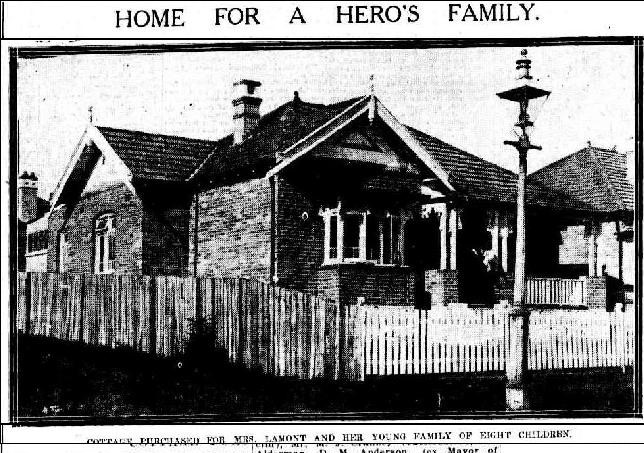
Sergeant-Major C. R. Lamont, formerly instructor to the Edgecliff Rifle Club, was killed in action at Gallipoli between August 21 and 25 last. The deceased was 47 years of age, and he left a widow and eight children, the eldest being 10 years old.
The members of the Edgecliff Rifle Club were deeply grieved when the news came by cable on September 28 last that their popular instructor had fallen in battle. They called a meeting with the view of making provision for Sergeant-major Lamont's widow and young family. It was decided to form a committee to raise funds to purchase a home for Mrs. Lamont. The committee consisted of Mr. David Davis (chairman), Captain Ruskin Rowe(captain of the club), Captain W. G. Conley, Rev. Canon Lea, Messrs. W. Ogilvie (hon. secretary of the club), W. Carter Smith, Claude Healey, T. H. Joyner, Percy L. Williamson, and Ernest R. Cohen. The latter two acted as hon. treasurers to the fund. |
The members of Tattersall's Club co-operated with the Edgecliff Club with satisfactory results. Mrs. A. J. McDonald (whose husband, Captain McDonald, is in the fighting line), Mrs. C. S. Davenport, and Mrs. R. P. Blundell, and a number of gentlemen organised a successful entertainment at the Wentworth Hotel last November. The result of the combined efforts was that the Edgecliff Club and Tattersall's Club each subscribed about £260; the Wentworth Hotel fete realised £160net. Other contributions brought the fund up to about £715. Among the prominent sub-scribers was Mr. George Barnett, who marked Cetigne's victory in the Derby by giving £100 to the fund.
With this sum in hand a sub-committee was formed, consisting of Mr. David Davis (Edge-cliff), Mr. M. J. Cranney (Tattersall's), and Alderman D. M. Anderson (ex Mayor of Ryde), the last named acting for the promoters of the Wentworth House entertainment. These gentlemen were entrusted with the selection of a house suitable for Mrs. Lamont and her little ones.
After considerable difficulty, the sub- committee purchased a cottage at the corner of Orchard and Merion streets, Ryde, four minutes' walk from the railway station. The cottage is of modern construction, built of brick on stone, with tiled roof. It contains three bedrooms, a large dining-room, kitchen, and laundry, and has a sleeping-out verandah at the back. The title to the property is Torrens, and the land has 50ft frontage to Orchard street and 132ft to Merion street. The cottage cost £600. A balance of about £115¡n the hands of the sub-committee will be applied to the payment of rates, taxes, and re repairs as they become due. Mr. P. L. Williamson and Mr. E. R. Cohen are doing the legal work gratuitously.
Mrs. Lamont, in expressing her gratitude to the subscribers, states that she is delighted with her new home, of which she will take possession next week. Mrs. Lamont has relations and friends in St. Kilda, Victoria, who wished her to remove there. She, however, preferred to stay with the Sydney people, by whom she had been so well treated. HOME FOR A HERO'S FAMILY. (1916, March 16). The Sydney Morning Herald (NSW : 1842 - 1954), p. 5. Retrieved from http://nla.gov.au/nla.news-article15655517
MR. RUSKIN ROWE had the coveted distinction of holing the third, on the short course at Rose Bay, in one during the week-end. It must be interesing to be a popular architect, for while few men are remembered after they are gone, Mr. Rove will always be kept In mind by the stately and chaste building owned by the Royal Automobile Club, of which Mr. Rowe was the honorary architect. SOME ROUGH NOES ON GOLF (1928, April 18). Evening News (Sydney, NSW : 1869 - 1931), p. 3. Retrieved from http://nla.gov.au/nla.news-article115523528
ROYAL AUTOMOBILE CLUB. BERT HINKLER A LIFE MEMBER.
At a meeting of the Royal Automobile Club last evening, Mr. Bert Hinkler was elected an honorary life member of the club. The honour has been conferred on only three other people-Messrs- Harry Skinner, H. Ruskin Rowe, and Herbert M. Ross. ROYAL AUTOMOBILE CLUB. (1928, April 27). The Sydney Morning Herald (NSW : 1842 - 1954), p. 12. Retrieved from http://nla.gov.au/nla.news-article16460027
A GENEROUS OFFER.
The action of Mr. H. Ruskin Rowe, of Messrs. Ross and Rowe, architects, who has given his services in connection with the erection of the new club house, is referred to as follows:
'The committee had practically decided to invite architect members of the club to submit competitive designs for a building at the corner of Macquarie and Albert streets; but at a special meeting a letter was received from Mr. H. Ruskin Rowe, a member of the club, of Messrs. Ross andRowe, architects and consulting engineers, offering to place his professional services at the disposal of the club in connection with the erection of the club house, and to carry out all work associated with the architecture, the preparation of sketches, estimates, contract, drawings, details, and the usual supervision, as a gift to the club, and this generous offer was accepted.' A GENEROUS OFFER. (1924, December 14). Sunday Times (Sydney, NSW : 1895 - 1930), p. 22. Retrieved from http://nla.gov.au/nla.news-article128139125
Mrs. C. T. Rowe, widow of the late colonel Rowe, celebrated her 80th birthday last Wednesday. Her family entertained her at a dinner party in honour of the occasion. Those present Included Sir Arthur and Lady Rickard, Mr. and Mrs. Ruskin Rowe, Mr. and Mrs. Septimus Rowe, Mr. and Mrs. Trescoe Rowe, and Mr. Leo Rowe. SOCIAL & PERSONAL. (1934, February 3). The Sydney Morning Herald (NSW : 1842 - 1954), p. 7. Retrieved from http://nla.gov.au/nla.news-article17045106
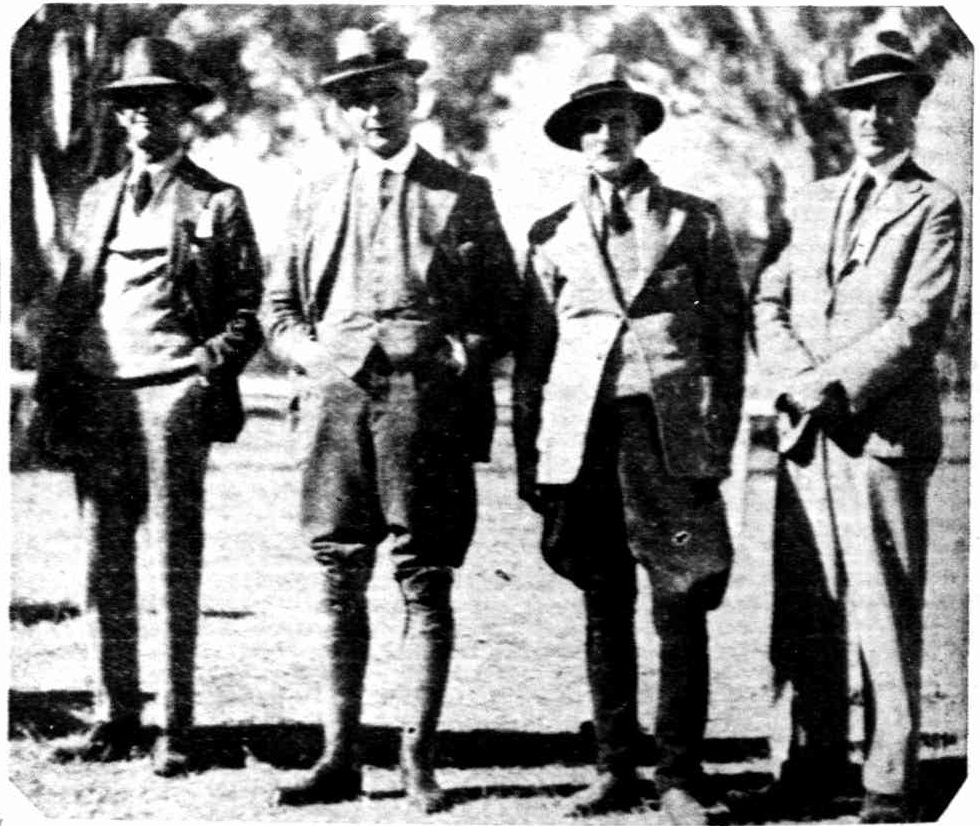
Sheep-men at Warren Show. From left; Mr. E. H. Wass, manager of Egelabra, Sir Norman Kater, of H. E. Kater and Sons, Egelabra, Warren; Mr. J. McKeachie, manager of Buttabone Stud Park; and Mr. H. Ruskin Rowe, managing director of Wonbobbie Pastoral Co., Warren. Fine Display of Stock at Warren (1936, June 12). The Land (Sydney, NSW : 1911 - 1954), p. 8. Retrieved from http://nla.gov.au/nla.news-article104231394
H. RUSKIN ROWE, ARCHITECT.
Mr. H. Ruskin Rowe, architect (late of Ross & Roe) announces that he has commenced practice at 350 George Street, Sydney. H. RUSKIN ROWE, ARCHITECT. (1939, April 5). Construction (Sydney, NSW : 1938 - 1954), p. 5. Retrieved from http://nla.gov.au/nla.news-article222854820
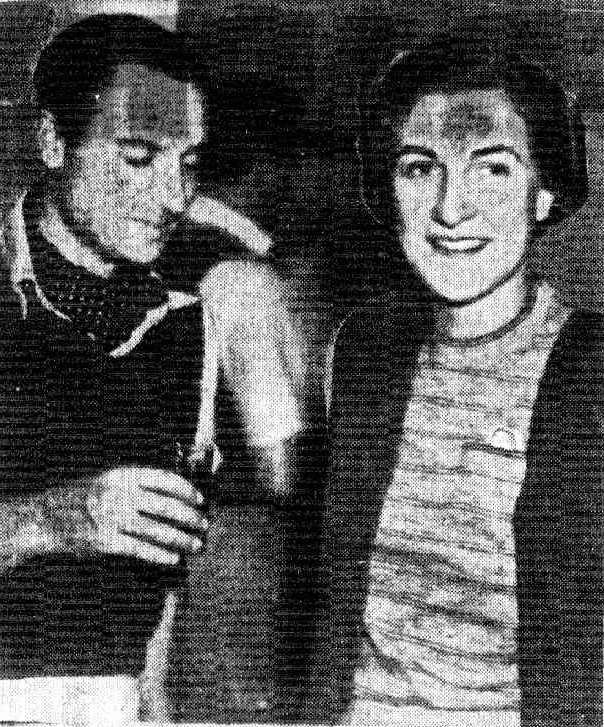
MR. GEORGE MORRIS and his fiancee, Miss Joyce Ruskin Rowe, who announced their engagement last week, at the dance at the Pacific Club, at Palm Beach, on Saturday night. Anniversary Weekend Dance Of Palm Beach Surf Club A Prelude To Gay Week (1938, January 24). The Daily Telegraph (Sydney, NSW : 1931 - 1954), p. 11. Retrieved from http://nla.gov.au/nla.news-article247399318
MORRIS-ROWE.-November 6 1939 at St Marks Church Darling Point, Augustus George Hamilton elder son of Mr and Mrs Herbert Morris, of Flerlys Edgecliff to Joyce Elizabeth Ruskin only daughter of Mr and Mrs H Ruskin Rowe of Double Bay and Wonbobbie Station Warren. Family Notices. (1939, November 11). The Sydney Morning Herald (NSW : 1842 - 1954), p. 16. Retrieved from http://nla.gov.au/nla.news-article17642255
Picture Hat Problem In Wind
AFTERNOON WEDDING AT ST. MARK'S
Gusts of wind made it a difficult task for Miss Joyce Ruskin Rowe to retain her large white picture hat at a correct angle as she arrived at St. Mark's Church, Darling Point, yesterday afternoon, for her marriage with Mr. George Morris. Her smart afternoon frock of white suede crepe was made with draped pleated bodice, pleated sleeves, and panel in the skirt. To the sleeves she fastened a cluster of lily-of-the-valley tied with white ribbon.
Heirloom Necklet
She added a gold chain and pearl and diamond necklet, which has been worn by the bride of the eldest son of the Morris family for four generations. The bride is the only daughter of Mr. J and Mrs. H. Ruskin Rowe, of Double Bay and Wonbobble, Warren. The bridegroom is the elder son of Mr. and Mrs. Herbert Morris, of Double Bay. The bride was unattended, and Mr. Peter Lister was best man. Only a few close friends and relatives were present at the ceremony. Afterwards one hundred and fifty guests were present at a reception at the Royal Sydney Golf Club. The bride's mother, who was hostess, wore a tucked gown of pervenche blue romaine with a navy straw hat trimmed with blue veiling.
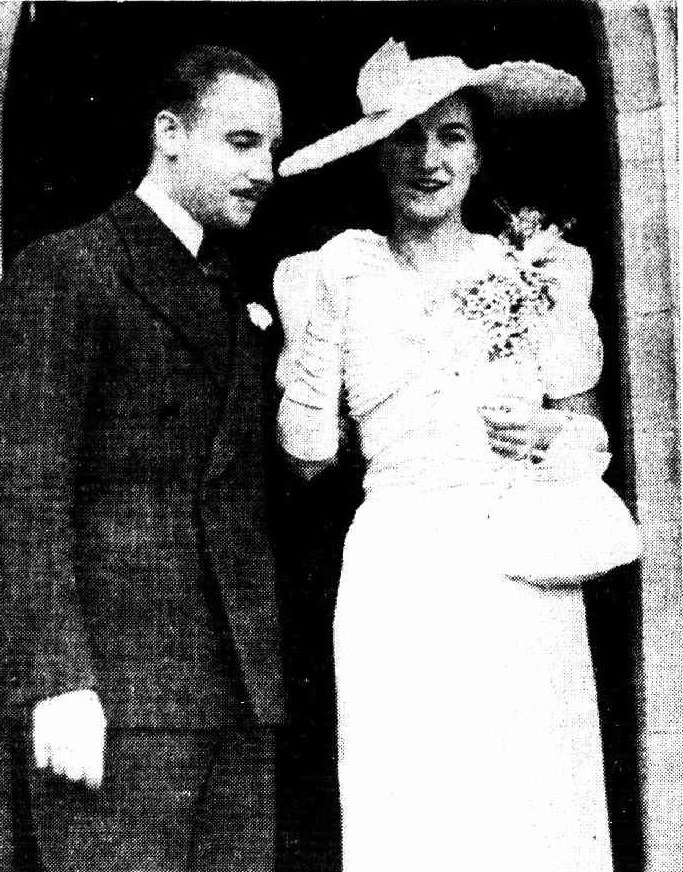
MR. AND MRS. GEORGE MORRIS leaving St. Mark's Church, Darling Point, after their marriage late yesterday afternoon. The bride was formerly Miss Joyce Ruskin Rowe. Picture Hat Problem In Wind (1939, November 7). The Daily Telegraph (Sydney, NSW : 1931 - 1954), p. 10. Retrieved from http://nla.gov.au/nla.news-article247827275
Joyce Elizabeth Ruskin Morris passed away in November 1959, her death was registered at Dubbo in 1958. She was only 41 years old. Her remains were placed in the Morris family plot at Manly Cemetery along with:
Morris Augustus Plot No: B.424 date of internment: 1895.08.31 Age: 75 30 Y 1127
Morris Joyce Elizabeth Ruskin Plot No: B.424 date of internment: 1957.11.19 Age: 41 Y 1127 Not in Burial Register
Morris Ada Marian Plot No: B.424 1969.07.31 Age: 89 Y 1127 Not in Burial Register
Morris Doris Evelyn Mary B.424 1981.07.03 Age: 67 Y 5949 Not in Burial Register
Morris Augustus George Hamilton B.424 1990.01.23 Age: 75 Y 5948 Not in Burial Register
______________________________
Beresford's beautiful wife - 20 March, 1949 - they had a son, Ross, prior to their daughter being born -one of their grandchildren was named 'Anthony':
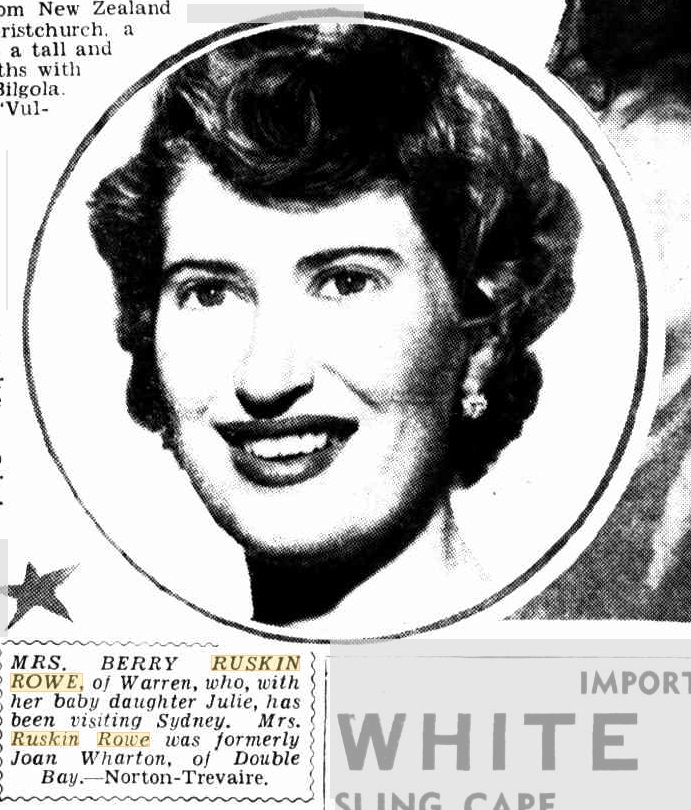
Control of Blowfly Strike; Board's Claims Questioned
THE article in last week's Issue of "The Land," in which the Australian Wool Board claimed that an, effective control of blowfly strike had been achieved at last, has provoked spirited discus*ion'and protests in pastoraI circles.
The Board claimed an incidence as low as 1 per 1000 in some cases, despite fly activity. At Gilruth Plains, the incidence was 1 per 100 sheep, as against, 75 per 100 in the untreated ,croup, .All this, it was stated, was achieved by the adoption of the 4-In. tail and (lie Mules operation, which eliminates the wrinkles.in the crutch.
Mr. H. Ruskin Rowe, a well-known Sydney architect, who owns extensive grazing properties in the western areas, told "The Land" this week that graziers out Warren way were Astounded at the Board's claims.
On his 10,000 acre "Wonbobbie" station, Mr. Ruskin Rowe declared, ail his sheep had the 4-in. tail, and great numbers of them have an absolutely Plain crutch, better than any Mules operation could give, yet the strike incidence this season had been up to 80 per cent., and about 30 per cent., of the sheep have been struck on the back, shoulder and neck.
"I can only surmise," added Mr. Ruskin Rowe, "that the Board's tests have been made in some dry Queensland area where the flies were not very much in evidence,"
Touching the Mules operation, Mr. Ruskin Howe said it was a valuable help, but with about 52,000,000 sheep in N.S.W. and the grazing areas denuded of manpower, it was going to be a very long time before it could be completely adopted. The 4-in. tail was another valuable help, but he had found jetting to be costly and not entirely satisfactory.
Body Strike This Year
Mr. T. McCarthy, Chief Entomologist, N.S.W. Department of Agriculture, said body strike in sheep was unusual, except in seasons when flies were exceptionally numerous. This was one of those particular seasons.
The best control measure, he said, was jetting, combined with clutching. That, he believed, would afford the greatest protection against the worst blowfly invasion.
The Mules operation, he added, was of great value in combating fly strike, and had come to stay. Control of Blowfly Strike; Board's Claims Questioned (1942, November 20). The Land (Sydney, NSW : 1911 - 1954), p. 15. Retrieved from http://nla.gov.au/nla.news-article105757778
Railway to Darwin
SIR, — Having read the excellent articles in the Telegraph by Mr. R. G. Casey on the Northern Territory, I thought it would not be amiss to bring under your notice the most urgent and vital necessity of developing the Territory — above all, the Bourke-Darwin railway. Mr. Casey, after far-reaching investigations, point-ed out that first we must develop the cattle industry. Knowing this country, particularly from a drover's point of view, I fully concur with this. Few Australians know the conditions, and, I am sorry to say, most seem little interested — particularly our Federal politicians.
I was one of the original sponsors of this Bourke-Darwin railway. We had arranged preliminary surveys and the vital matter of money. Our group included the most experienced railway engineers, and some of the most experienced and successful business men in Australia: The Bruce-Page Government promised us the" right to construct this, railway, but unfortunately the Scullin Government, which followed in 1932, said the Government would build it.
The Government, of course, built no railway. The result was nearly national tragedy when the Japs attacked. We had to use valuable manpower and machinery on building a road to Darwin. These roads were m magnificent condition when the Army maintained them. I am sorry to forecast that in a few years they will not be even in existence The Darwin railway, in one serious drought alone, would more than pay for itself by saving the scores of thousands of cattle which regularly die over the arid regions between the waters.
Such a film as "The Overlanders" should make the more intelligent Australians think, and, I hope, do something. Sir George Buchanan's report of 1925, the reports in 1928 of the Federal-Commission on the development of the Northern Territory, and the reports of the Federal Pastoral Advisory Commission and other commissions and commissioners, all unanimously agree that the Bourke-Darwin railway is a first essential to develop the Northern Territory, make it safe, and assure, a White Australia.
— H. RUSKIN-ROWE.
Architect, George Street, Sydney.
Railway to Darwin (1947, May 23). The Daily Telegraph (Sydney, NSW : 1931 - 1954), p. 6. Retrieved from http://nla.gov.au/nla.news-article248485889
HAVE you ever been to a Ding? No? Nor had I till I went to one at Avalon during my visit to that siring of plush plages that fringe our local coastline.
"The Silent Hundred" is a group of young bloods so-called because they make more row than a thousand amplified corncrakes. . . ! They number eight, all told . . . handsome, hilarious Lotharios of Sydney. 'Twas these who gave the Ding!
For the month of January, this gaggle of gorgeous guys rented the Ash home, recently built on the Ruskin Rowe Estate at Avalon, in which to pass their vacation.
I know only two of the hosts ... Owen Cotter, a banker, descended, I ween, from the cricketing Cotters, and Bruce Dawson, a budding film exhibitor whose "Pa" owns the Savoy Theatre, that little cinema we so delight to patronise. But about the Ding; and was I curious? It turned out to be the final blow-out before the call of the bundy summoned the eight vacationers back to town.
Two hundred and fifty guests— the cream of the youth at present in pursuit of pleasure on our fashionable beaches, and the very young marrieds, presented themselves en gala for the fiesta.
A whole of that blissful neck o' the woods which is. actually behind Avalon, in a verdant valley, was by the time we got there alive with the sounds of revelry, sweet, music, gay laughter, and the gurgle of the tide of beer as it ebbed in the countless kegs which the generous hosts had provided.
AT the back of the house, a roaring fire, perpetually being stoked, was in readiness to receive hundreds of hunks of protein for barbecueing. Everywhere was abundant and beautiful' youth . . . male and female. Chief Serang Cotter greeted us. His top half belonged to the R.A.A.F.; his lower resembled the hero of any South Sea island film.
He must, however,, have been impressed by the descent upon the Ding, of the "elders," for he trotted out the gin for us from a secret cache ... not possibly to be revealed to the younger set.
Like royalty, we were conducted to all points of interest . . . escorted by a heavenly bulldog— a lady of high degree— and, like royalty, after an hour, we withdrew ... took ourselves off . . . leaving the ever-increasing numbers; crashers included; in the arms of Bacchus or Eros, or both.
Throughout the night— till the dawn, at Bilgola, we could hear the young things of the neighborhood returning home. That Ding was in truth; a Dong. Postscripts (1953, January 25). The Daily Telegraph (Sydney, NSW : 1931 - 1954), p. 33. Retrieved from http://nla.gov.au/nla.news-article248880387
